52 Incredible Indian Folk Art Forms That We Must Protect In Indian Art And Culture:
Welcome to our exploration of 52 remarkable examples of Indian folk art, a vital part of our rich Indian Art & Culture. This article aims to raise awareness about these incredible art forms, with the hope of reviving and passing them down to the next generation.
My journey began in 2019, with the discovery of around 10 traditional arts at risk of fading away. As I delved deeper into my research, I uncovered even more art forms in need of preservation.
Indian folk art and craft possess many fascinating aspects that often remain unexplored. In this article, we examine the history of Indian folk art, showcasing how it has survived and evolved over thousands of years into its present form. It is crucial to take action now; without care and attention, these cultural treasures may be lost forever.
We encourage you to approach this article with an open mind and invite your feedback in the comments below. Your insights can help others appreciate and learn from this vibrant cultural heritage.
We, at International Indian Folk Art Gallery are doing our part, Read more…
The Importance of Understanding Indian Art and Culture
While exploring the history of culture, it is essential to understand the background of each country. India, with its rich history and influence on other cultures, has a lot to teach us about culture.
India is the most populous country in the world, with over 1.4 billion people living in it. It is home to some of the most ancient civilizations, and has a long history of cultural richness to boast about.
While India was a place where many scholars and intellectuals found refuge from colonialism, it also became a place where many ideas were exchanged and creative works were created.
India has a long and diverse history. The country has been through many eras and has influenced other countries in numerous ways. From Vedic philosophy, to the teachings of Buddha, India has always been at the forefront of culture-changing ideas
Culture is an important part of any society. It can help or hinder the way a nation creates, develops, and progresses. Culture is constantly evolving with time.
Cultures and creativity both affect economic, social, and all other aspects of activity. The country of India is one of the world’s most culturally diverse countries, as it has been home to a multitude of cultures for millennia.
This diversity in Indian Art and Culture is symbolized by the plurality of its culture. India has one of the world’s largest collections of songs, music, dance, theatre, folk traditions, performing arts and rites and rituals.
Indian art and culture is one of the most fascinating cultures to study. It is a place where stories are told through art, dance, music, food, and customs. To understand the rich history of India, you should start by subscribing to stories that are told in folk art.
The Indian folk arts are an important part of the nation’s culture and identity because they are directly connected with spiritual nature of people’s lives.
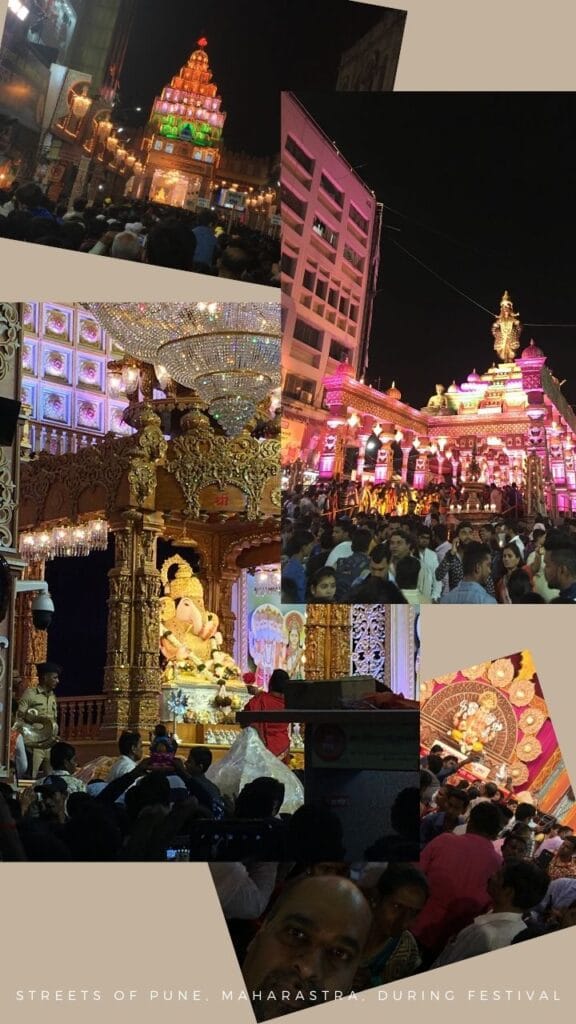
What is Indian Folk Art?
In Indian Art and Culture, one of the few forms of entertainment in ancient India was folk arts. Indian folk arts are culturally based art forms that are handed down through generations. These traditional art forms include music, dancing, puppetry, storytelling, and much more. This is a very unique feature of Indian Art and Culture.
In Indian Art and Culture, the art of storytelling has been around for as long as humans have been telling one another stories. It has evolved over time to reflect changes in technology and religion and social norms. It is said that storytelling first began with the fire story – where people would gather around a fire at night and tell each other stories.
Traditional Indian Folk art is a term that refers to the artwork of people who are not professional artists, such as painters or sculptors, and is often created in isolation. In our Indian Art and Culture, the term “folk” imply an emphasis on originality and simplicity: no formal qualification is required to produce folk art, and the style of work reflects the culture from which it originates.
Folk arts are artistic traditions that originated in a common context and were passed down through generations by being taught informally, this is so much the heart of our Indian Art and Culture. They include painting, drawing, sculpture, printmaking, blacksmithing, pottery-making, weaving, or other textile arts such as quilting-crocheting-knitting; ceremonial object making; decorative object making.
Indian Art and Culture has always been a melting pot of cultures and traditions. It is also one of the few places in the world that have preserved centuries-old folk art through its heritage and vibrant culture.
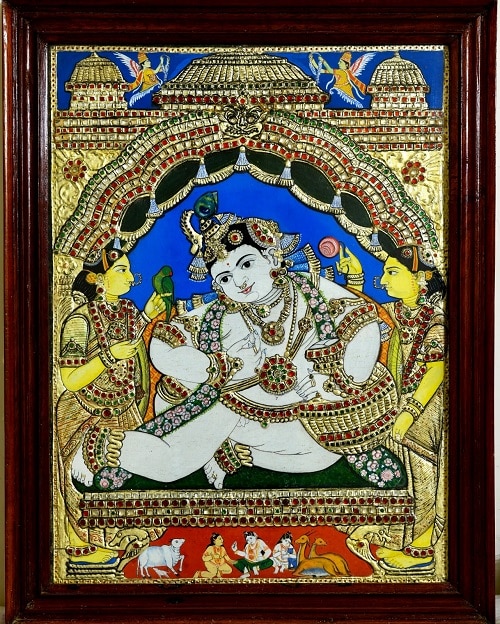
Indian Folk art, which is the term used to refer to artistic expressions made by hand, continues to be relevant and popular in India even today. The art forms are not only practiced by rural folk but also enjoyed by city dwellers.
Indian folk art is a country’s heritage and can be representative of the culture and history of that country. It is the most original work of art because it is born out of the soul of the people.
The Indian government has taken many initiatives to keep this rich cultural traditional art alive. They are making it easier for future generations to access this heritage which will help diversify the country’s culture even more. However, government alone cannot stop the extinction of these traditional artforms without support from every Indian, living in India or abroad.
Why Do We Need to be Concerned about the Future of Indian Folk Art?
India is home to over 50 traditional folk and tribal arts. These Indian folk arts have been passed down from generation to generation for more than 3000 years. However, a large proportion of these traditions are at risk of extinction. The once-thriving community of artists is now dwindled down to a couple of families fighting to keep the art alive.
Indian Folk Art is a very important and respected part of Indian culture. It has been preserved and perfected by generations of artisans. The art form was created to fulfil the needs of the community, who learned to use materials that were readily available to them such as clay, straw, wood, and more.
The pre-modern world was full of colors. This artisan also learned to extract colours from vegetables, fruits, flowers and stones. For example, red ochre is made by grinding clay and adding it to animal fat; white would be extracted from rice or sea shell, yellow from stone called “hardital” and so on.
These beautiful works can be seen in temples, homes, walls and even on pottery.
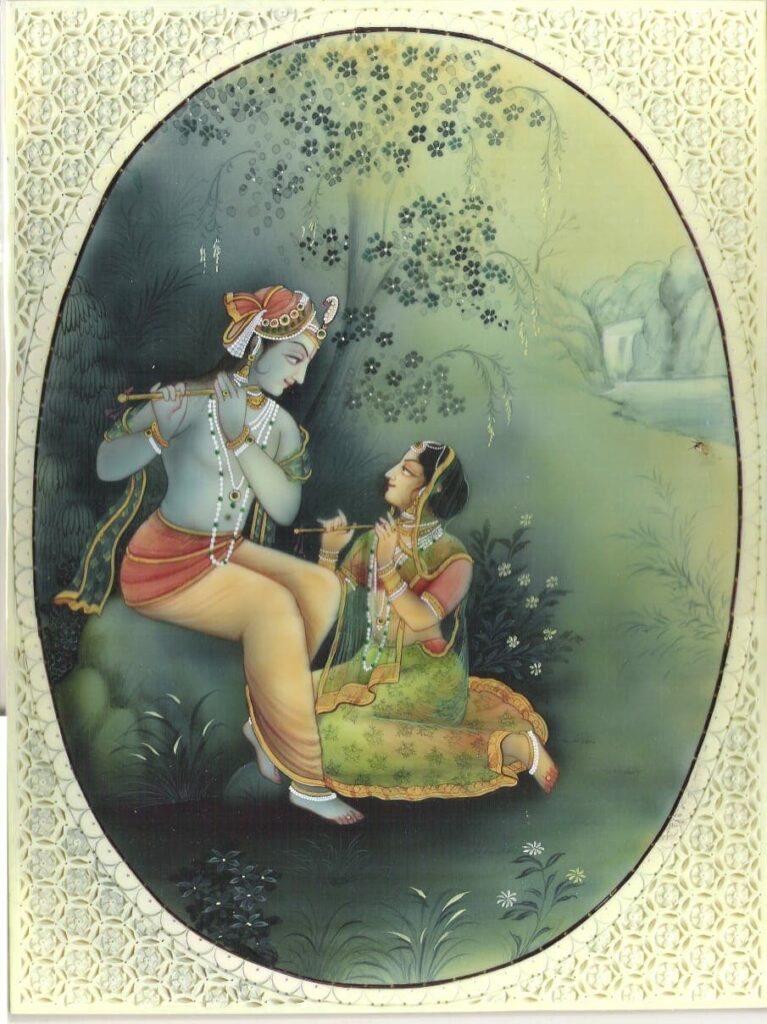
Indian folk art is an important cultural tradition in India. It has been passed down through generations and is deeply connected to the culture of this country. Folk art also has a special connection with the rural communities in India.
It would be a shame if folk art was not preserved for future generations because it might end up disappearing to the archives of museum curators who only care about it when there are no more people to appreciate it.
The Truth Behind How These Indian Folk Arts are Disappearing
The truth behind how these Indian folk arts are disappearing is complex. There are many different contributing factors that have caused the disappearance of these folk arts.
We can start looking at how westernization has impacted these traditional cultures. Westernization has had a negative effect on the cultural identity of these traditional artists, buyers and their beliefs. This has led to change in what they made, what was made for them, and how it was made.
There are also external forces that have contributed to the disappearance of these folk arts including colonialism, poverty, technology, globalization, and urbanization.
The folk arts are being threatened. As the world becomes more globalized, poverty is on the rise and technology is becoming more advanced, folk art has slowly disappeared due to the lack of funding and interest.
What's the Future of the India's Dying Folk Arts?
In the past, folk arts were a way for people to express themselves and pass down traditions from generation to generation. Nowadays, more and more of these folk arts are dying out as the way of living has evolved and adapted around western culture.
Folk arts include all types of folk art such as music, dance, painting and so on. These types of arts have been around for many centuries and have been passed down from one generation to the next in some cultures.
Indian folk art has become a dying art. The lack of awareness about these folk arts among the new generations of art collectors, both in India and outside has led to this sad situation where these folk arts are slowly disappearing.
Young people are not taking up the profession due to its low earning potential.
The Cheriyal scrolls of Telangana, the Chittara of Karnataka, the Dhokra of West Bengal, the Kavad of Rajasthan, The Leather Puppet of Andra Pradesh and the Rogan of Kutch are all endangered. India’s folk arts are all threatened because many traditions don’t make money and people don’t want to do them.
Folk arts need to be saved for their intrinsic value and not just as a way to make money. For them to survive, we need creative ways to keep these traditions alive and relevant by helping those who love the art but cannot afford it.
The Indian folk art is slowly being replaced by western art in our living rooms. While Indian folk art has maintained a unique identity, it is steadily losing its relevance in both the domestic and global art sphere.
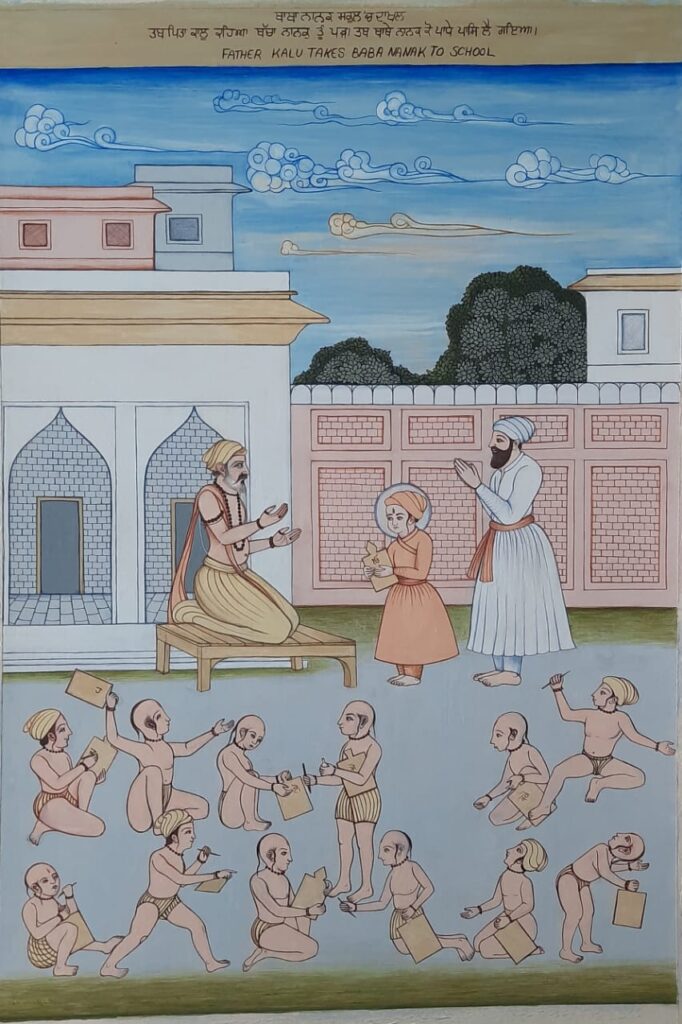
In conclusion, some of the reasons for the decline of this art form are:
- Lack of patronage (art collectors transitioning to western artforms)
- Lack of training and skill transfer
- Dealers and galleries driving costs down for higher profits
- Poor knowledge and infrastructure to promote these artforms
- Indifference to rural life by urban elite cultures.
The future of this art form will depend on how artists themselves react to these challenges and how various stakeholders react to the importance of preserving our own traditions.
What has been the impact of COVID 19 pandemic to Indian Folk Artists?
India is one of the most visited tourist destinations in the world. Tourism is very important in India. It creates ₹16.91 lakh crore (US$240 billion) of revenue, which is 9.2% of the country’s gross domestic product, and supports 42.673 million jobs or 8.1% of total employment. Over 10.93 million foreign citizens visited India in 2019, with this number doubling the 10.56 million of citizens who came to visit last year. This is an increase of 3.5%
Economic turmoil is an indisputable reality in today’s climate. The COVID 19 pandemic, which caused severe outbreaks in India, has severely diminished India’s tourism industry, causing severe shortage of buyers for Indian Folk Art.
Indian artists and artisans have been hit hard by the COVID 19 pandemic, with many losing their livelihoods. Tourism has been severely affected, with fewer foreigners coming to India and fewer Indians travelling overseas.
This not only affected employment rates but also contributed to a decline in demand for these traditional art and crafts.
The COVID 19 pandemic has caused economic turmoil in India and its effects would be felt in the art and craft industry for years to come. Many skilled artists and crafters left their fields and later took up other jobs. Some, who could afford have started to build their inventory level, hoping for demand to return.
Most folk artists in India are with no formal education, and their earnings are limited to what they can sell. Unfortunately, most of their sales are through foot traffic and they do not have the knowledge, money or the infrastructure to sell online.
52 Incredible Heritage of Indian Folk Art that We Must Protect and Preserve for the Next Generation
The Indian culture is rich and diverse with many beautiful things to see. But the best part about India is the folk art. India has a rich tradition of folk art which has been passed down through generations.
Indian folk art has always been an important part of the culture. It’s not just an artist’s expression but also a way to portray their stories, memories, values and beliefs.
Along with all the amazing things that India has to offer, it also has its own set of problems. The problem that affects Indian Folk Art most is that people are losing interest in it because they don’t see much value in it anymore.
Indian folk art is made up mostly of two distinct forms: applied and decorative arts. Applied arts refer to the crafts that are created with a specific function and decorative arts refer to those that are made for display purposes. Both types have played a vital role in India’s economy and culture since ancient times.
Here are my top 52 Indian folk arts that we all must appreciate and try to revive.
1 - Aipan Art (Uttarakhand)
Aipan art originated from Almora in Uttarakhand, which was founded during the reign of the Chand dynasty. It flourished during the reign of the Chand dynasty in the Kumaon region.
The Chand dynasty was a Hindu Rajput dynasty that ruled much of the northern Indian subcontinent around the 10th century.
The art form has many regional variations. It’s origins are in the North Indian state of Uttarakhand. Aipan art is an ancient style of painting depicting mostly Jain, Hindu and Buddhist themes. The designs and motifs in Aipan Art are motivated by the beliefs of the community and various aspects from nature.
Some people believe that writing on empty walls with a reddish paint brings about good fortune. Others believe that this is just an aesthetic custom which has no meaning, but it’s still pretty cool.
The creation of rice flour art has deep cultural and religious significance in Kumaon. It is often found on the floor and walls of Puja rooms, as well as at entrances to homes. This form of artisanry is mostly practiced by women from this region
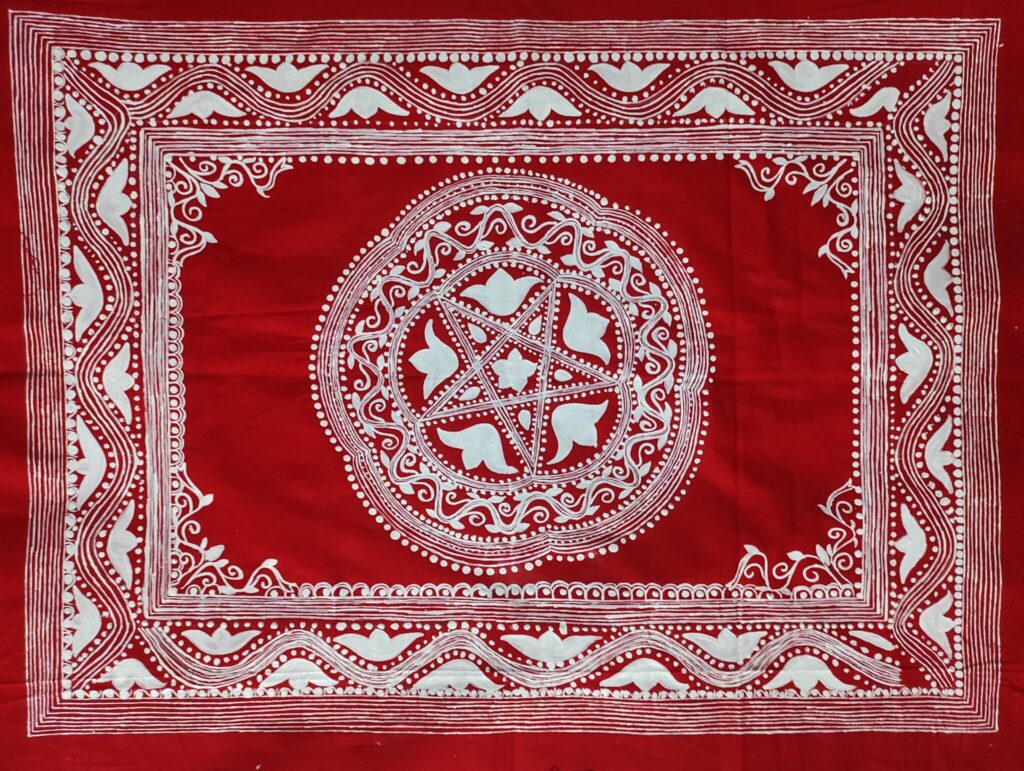
Aipan art is a type of folk art that originates in Kumaon in the Indian Himalayas. It is done at special occasions and rituals usually.
2- Assamese Miniature Painting (Assam)
Assam has a rich history of its tradition, art and culture and it flourished in the 16th century. The Bhakti movement spread in medieval times, thanks to Sankaradeva’s work (1449-1569) and helped create a culture of lively paintings.
Assamese Miniature painting is a technique in which art is painted on a small surface. The size of the painting varies from 1 inch to 24 inches in height and 8 inches to 12 inches in width. It is often made on ivory, wood, metal or paper
Assamese manuscript paintings may be grouped under the following categories. 1. Sattriya or Sankari style, 2. Gadgayan or Royal Style 3. Darrangi or Folk Style 4. Tai Style.
The process of making an Assamese miniature starts withdrawing outlines for the composition on paper. The outlines are then filled with color using water-based paints or gouache. The final step involves inserting miniscule details to the entire painting after it has dried up completely.
It is said that the latex of Kendu tree duck’s eggs or tamarind seeds were used as adhesive with all the colours. But the fruit of Wood Apple was used as the best adhesive. The proportion that you should mix the adhesive to colour is illustrated.
Assamese manuscripts are traditionally drawn on bark of the agar leaf, tulpap (paper pulp made from tulas leaves) or wooden plates. Sanchipat is a local writing material that cannot be found elsewhere.
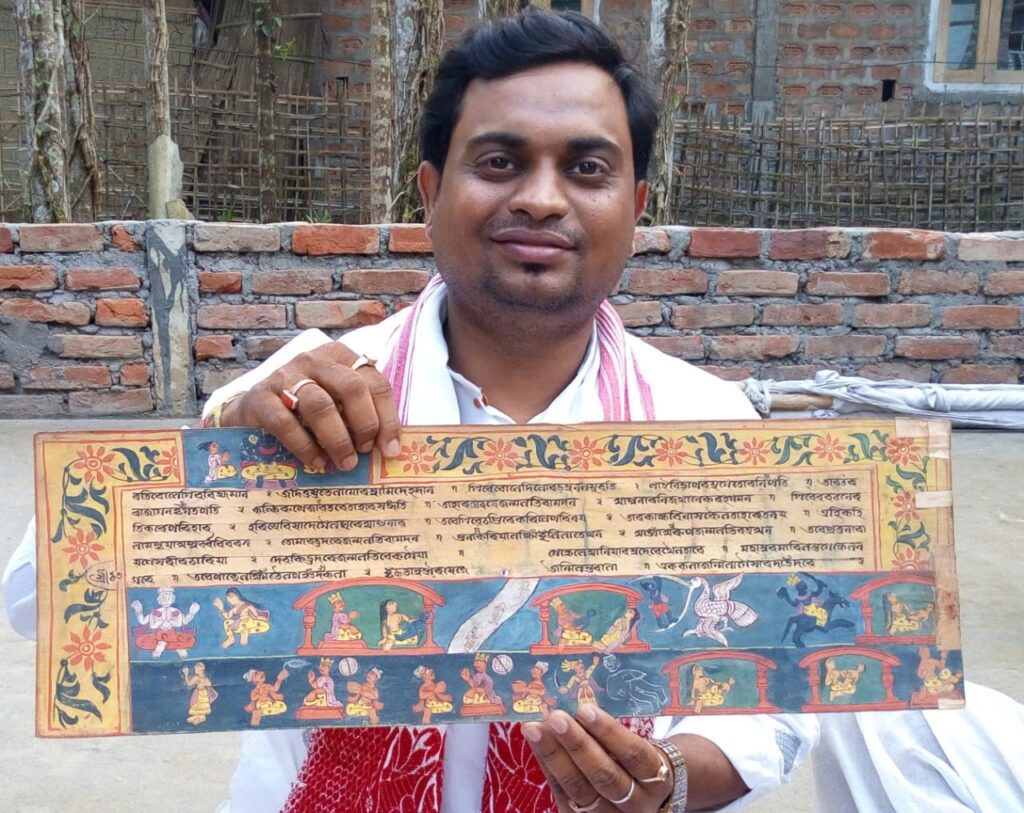
The Agar tree is a medicinal plant, and as such, its preparation procedure is unique. Moreover, the tree is a very expensive one to acquire the bark from it in order to make Sanchipat.
It is very interesting to learn about how traditional ink was extracted to write manuscripts in medieval Assam. This shows how passionate and curious the people there are. Ink or Mohi was generally prepared with extracts of Silikha, Keheraj, Amla, and bulls urine and barks of some of the trees.
The extract collected from Kechu (earthworm) and blood of Kuchia ( Asian Swamp Eel ) may also added to enhance the brightness of ink.
The other necessary units for preparing a manuscript such as well craft pens are made of bamboo, quill and a kind of fern called Kaap Dhekia. Hand made brushes are made from squirrel hair. The measuring equipments are called kathi which are made of bamboo and used to measure the alignment of text.
3- Bhil Painting (Madhya Pradesh)
The Bhil Tribe are native to western and central India. Today, there are fifty of them, which makes them the third largest community in India. The Bhil tribe once used to be mainly hunters back in time and they were skilled archers too.
They have long taken to agriculture and some have migrated to large cities taking up masonry, road making and other manual labour.
Art is integral to the Bhil community. Song, dance and painting, accented with feasting and drinking is used to mark events, store memories and fight despair and disease. Steeped in rituals, symbolism and tradition, the rich textures of their paintings connect them to nature and the Adivasi life that is their legacy.
Bhil paintings are a form of folk art, an art produced by the common people or folk artists from Bhil community. It is believed to be the oldest surviving form of Indian painting and has been practiced for over two millennia.
The Bhils are a large tribal community residing in central India (Madhya Pradesh). They can trace their ancestry to Eklavya and Valmiki, who, they say, was actually from their community.
Distinctive Dots: Stories, prayers, memories and traditions are painted onto plain backgrounds in a symphony of multihued dots. The first step to learning the art for many Bhil artists began with mastering the dots.
Skillfully repeating equal sized, uniform dots in rhythmic patterns and colours. The dots are the distinct identity of Bhil art, and have multiple layers of symbolism. Inspired by the kernels of maize, their staple food and crop.
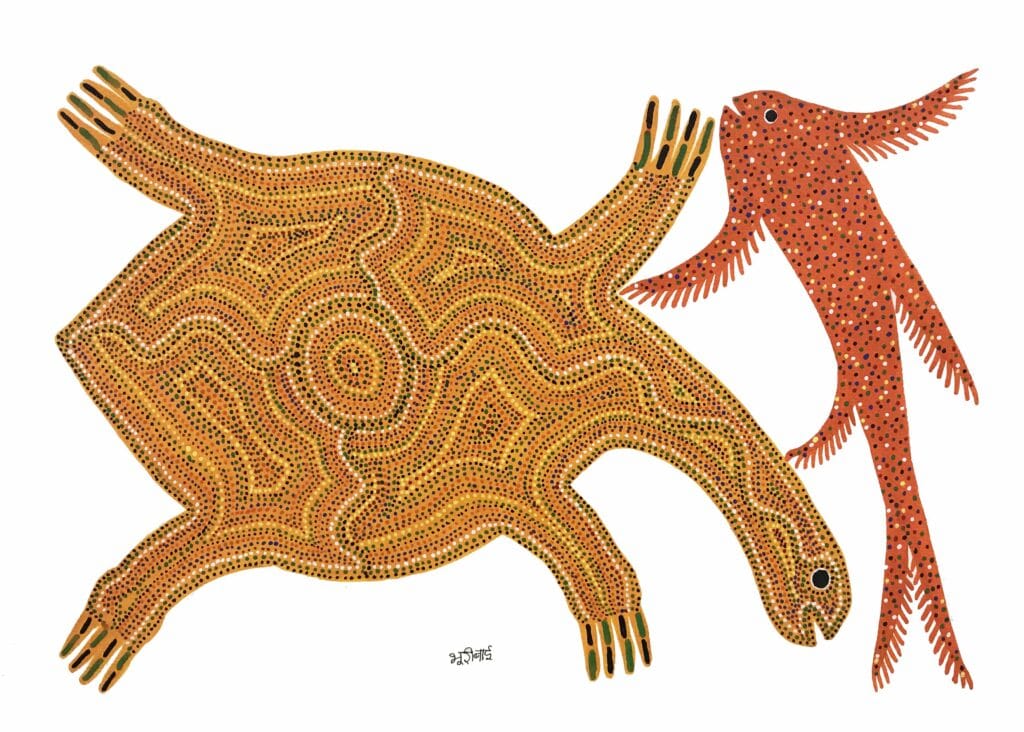
Each group of dots often represents a particular ancestor or deity. Additionally, each artist composes the dots in distinctive patterns encoding each art work with signatures visible to the trained eye.
These paintings were traditionally painted on the walls of their huts and the themes were centred on Mother Nature. They use a pattern of dots to fill in their paintings and are surprisingly similar to Australian Aboriginal art. Everything connected with the Bhil life is painted- the Sun, The Moon, insects, birds, fields, trees, mythological figures and their Gods.
4 - Bhojpuri Painting (Uttar Pradesh)
One of the most popular forms of art in Uttar Pradesh, Bhojpuri Painting has played a major role in the development and sustenance of art culture. Dating back to 1300 BC, it is even older than King Ashoka himself!
It’s difficult to gauge the exact origin of this art form. Certain facts from the past make us believe that these paintings surfaced during the reign of King Ashoka. Bihar is always being under the major hotspot for education, culture, and power.
Bihar is the 9th largest state in India. It is a historical and ancient land. The Bihar region was historically known as Magadha, one of the 16 Mahajanapadas of ancient India. Many great Buddhist scholars and monasteries lived in this land.
Bihar is a state with a rich heritage of culture and knowledge. It has been an education hotspot for many centuries
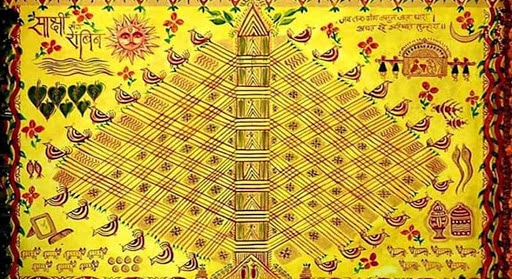
There are two major forms of Bhojpuri painting, Kohbar and Pidhiya. Kohbar paintings depict love and gratification, while Pidhiya paintings portray assorted subjects such as gods, goddesses, animals, plants and flowers.
The paintings at this Hindu temple are often related to Lord Shiva and Goddess Parvati, which according to the Vedas was not only a powerful union but also one of the most stable marriages in history.
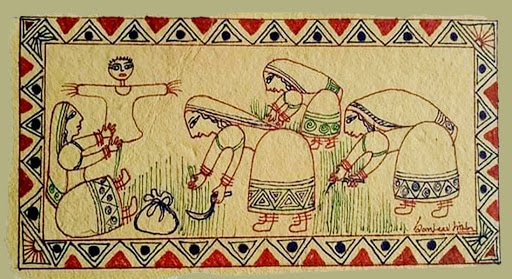
Bhojpuri Painting is often thought to profile Lord Shiva, Goddess Parvati, snakes, birds and lotus plants. It’s also a popular wedding gift as it’s thought to bring good luck to couples on their wedding day.
5 - Cheriyal Scroll Painting (Telangana)
The Cheriyal Scrolls paintings are made in Hyderabad. They are made by ragi dough that is shaped into scrolls and then hand painted with vegetable colors. The scrolls depict scenes from the Ramayana, Mahabharata or other epic folk stories.
The traditional art form was inseparable from the job of the story-telling, balladeer community known as Kaki Padagollu.
The scroll would go up to 40-45 feet long. It would usually be about 3 ft wide and written in vertical format. Traditional scrolls are set horizontally, meaning it shows the story spread across the page.
These canvas scrolls made from Khadi are hand-painted in a style unique to the local motifs and iconography. Characterised by a dominance of the colour red in the background, these brilliantly hued paintings even received Geographical Indication Status in 2007.
Painted in panels as a narrative, these are like comic strips from the past, depicting scenes and stories from Indian mythology and epics. Distinct in their style they immediately convey age-old Indian traditions and customs in a beautiful and engaging manner.
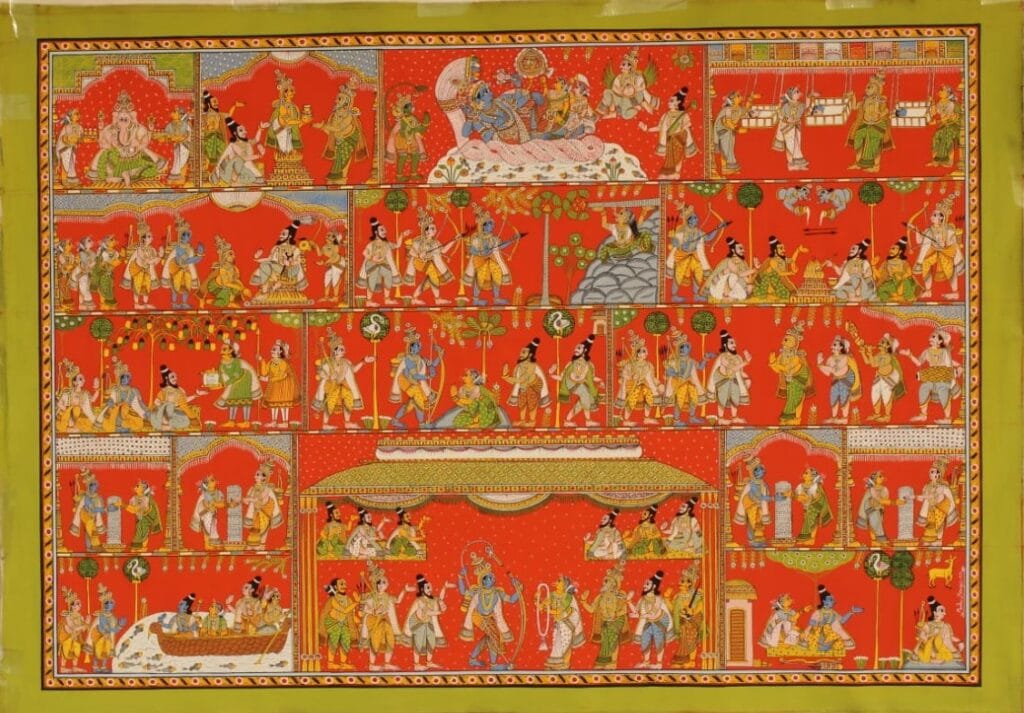
Of which, both the Lords Krishna and Rama are the most prominent and recurring. These painted scrolls were what kept the people of that era gone by entertained.
A floral border in the middle separates the two panels, while the linear narrative is demonstrated by holding in both hands or suspending it from a tree or a building and continually rolling it. Like large sized comic strips, each panel of the scroll depicted one part of the story. Hence, a scroll would easily have around 50 panels.
6 - Chittara Art (Karnataka)
-
Chittara Art is an autochthonous art practice. It is a ubiquitous cultural phenomenon of the Deevaru community, a matriarchal and an agrarian community of nature worshipers, residing in an around Sagar.
It is engaged primarily by the Women folk of the community as a socio-cultural practice, which embodies a microcosm of socio-cultural dynamic.
Nestled in the ranges of verdant western ghats of North Canara lives Deevaru community. Chittara drawings are intricate patterns, that represent the auspicious ceremony and rituals of life, symbolized in geometric patterns.
This requires a certain understanding of ratios and proportions, which the women of the community have been using with great dexterity. This folk art was and still is a part of their day-to-day life. It was never a profession, but a practice that has artistic and socio-cultural value.
The paintings are usually 2 – 3 feet in size, aesthetically refined, made of symbols representing their physical environment. They use eco-friendly natural resources like ground rice paste for white colour, roasted rice for black, yellow seeds (Gurige) red earth and the brushes are made up of Pundi Naaru.
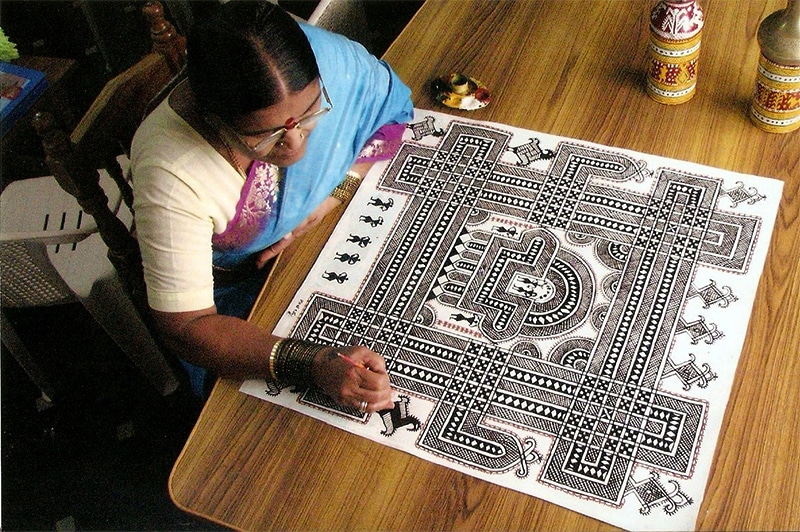
For women of the Deevaru community Chittara paintings are a source of great joy, beauty and creativity. They are proud of their tradition, socially bonded and culturally integrated by unique customs and ritualistic practices.
Undoubtedly, the wealth of artistic workmanship holds eternal value. Amidst the urban landscape, the treasures of handicrafts like Chittara will certainly provide enriching relief in our daily life.
7 - Chitrakathi Painting (Maharashtra)
Term “Chitrakathi” comes from two words: “chitra” meaning picture and “katha” meaning story. A Chitrakathi is someone who tells stories, with a visual aid. Tribal life has a long-standing tradition of such storytellers. Chitrakathi is an occupational caste whose traditional livelihood was to narrate stories aided with pictures sojourning various places.
Chitrakathi is a combination of two words from the Sanskrit language: chitra meaning picture and katha meaning story. With this app, a Chitrakathi is the one who narrates stories with a visual aid. There’s a long-standing tradition of this in tribal life
This art form, called Chitrakathi, is practiced within the Thakar tribe in Maharashtra. They are wandering musicians who perform the traditional stories at different villages.
They would make a series of single sheets of paintings. All paintings belonging to one story were kept in a bundle called a ‘pothi’. Painting themes include local versions of Ramayana and Mahabharata as well as mythological stories.
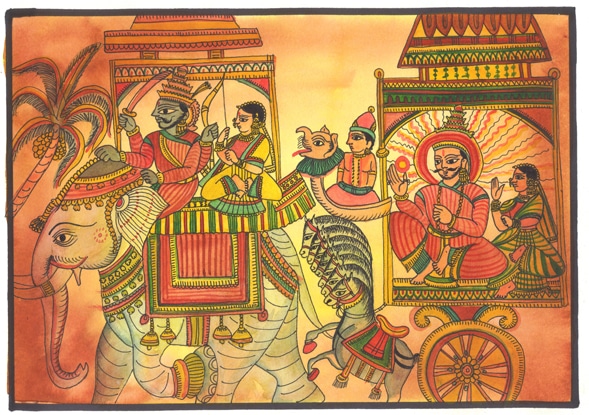
The use of brownish tones of stone colors gives a remarkable effect. Figures in paintings were generally stylized. These traditional art forms were lost in the villages of Maharashtra but the Greatest king of all times, Chhatrapati Shivaji Maharaj who were a lover of art, showed this talent to the world.
These stories were conserved during attacks in temples but after the times were better Maharaj revived them and honoured this beautiful art forms.
8 - Dokra Art, West Bengal
Dokra Damar tribes are the main traditional metalsmiths in West Bengal and Odisha, whose technique of lost wax casting is named after them.
Dokra Art (also called Dhokra) named after Dhokras tribe, a nomadic group that extends from Jharkhand to the southern state of West Bengal and the eastern state of Odisha. They can be traced back to a few hundred years ago when they traveled extensively, going as far as Kerala and Rajasthan.
Dokra (also spelt Dokra) is non–ferrous metal casting using the lost-wax casting technique. This sort of metal casting has been used in India for over 4,000 years and is still used. One of the earliest known lost wax artefacts is the dancing girl of Mohenjo-daro.
There are two main processes of lost wax casting: solid casting and hollow casting. While the former is predominant in the south of India the latter is more common in Central and Eastern India.
Solid casting is one of the most common techniques in creating an impression mould and only requires a solid piece of wax. Hollow casting, on the other hand, uses a clay core.
The process of creating beautiful Dokra Art.
To create an intricate, high-quality Dokra Art sculpture, the artist creates a model in clay. This is coated with wax so it can be cast in metal. The lost-wax process of wax casting involves two phases: solid casting and hollow casting. The wax is made up of pure bee’s wax, resin and nut oil.
To make a wax model, the parts to be cast are first coated with hairless wax, which is shaped to form a copy of the object. Fine clay is then applied over this and left in the shade where it hardens. When this is dry, a layer of more clay is applied and holes are made in it so that metal can be poured into them.
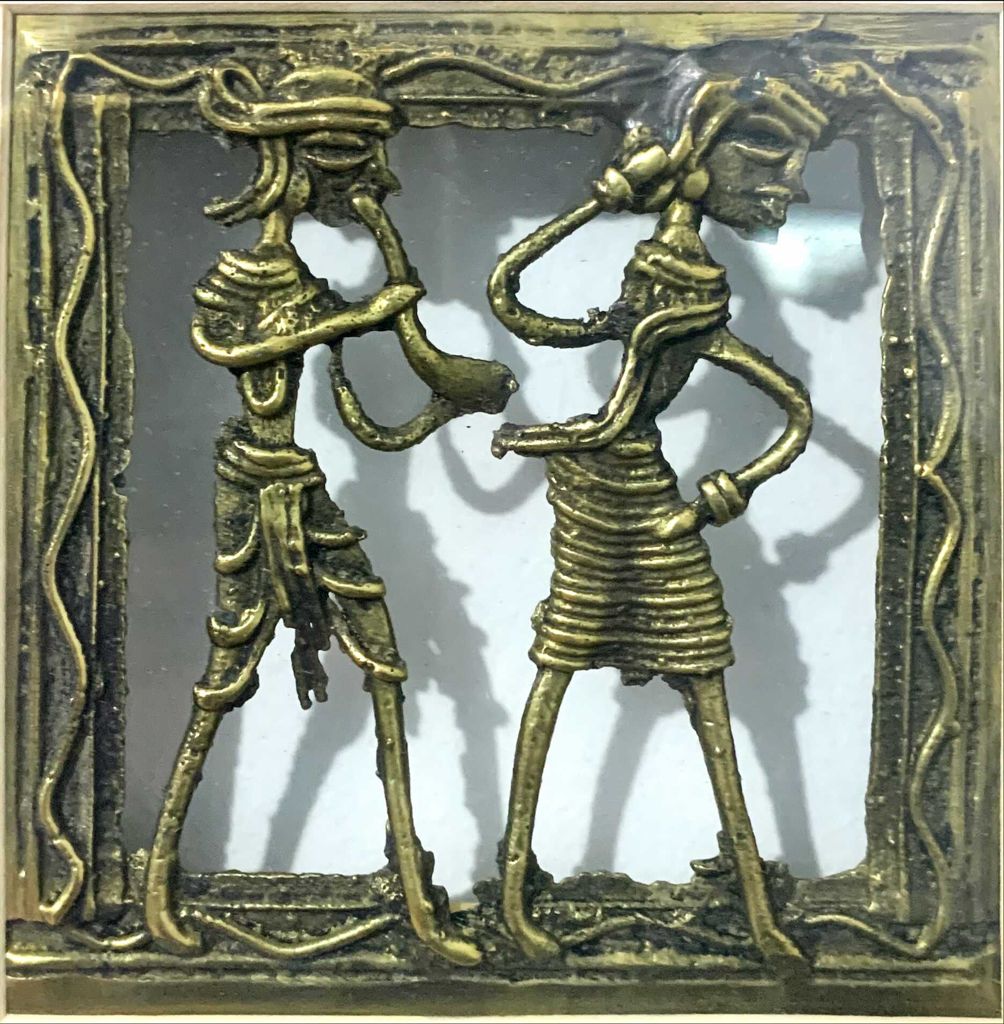
This sculpture is created by using clay, shapes, and molds. The clay model is sun-dried and later fired in a traditional kiln – this will cause the wax to melt and flow away from the mold through the holes. To complete this step, molten metal is poured into these same holes to cool down.
The traditional process of making a brass relief starts with the sculptor creating a clay model, which is then sun-dried. This process dehydrates the clay around the object, leaving it hollowed out. When cooled down, molten brass metal is poured into it through holes in the sculpture. This causes an expensive vacuuming process which removes any droplets of metal unable
9 - Kolam Floor painting (Tamil Nadu)
A Kolam is a geometrical line drawing made up of straight lines, curves and loops, constructed around a dot grid pattern. Kolams are generally considered auspicious symbols and are believed to bring prosperity to homes.
The kolam is made by drawing concentric circles around a central dot. The number of circles that are drawn denotes the number of evil spirits that can be eliminated from the premises. Kolams are generally drawn on clean floors with rice flour, jaggery, or chalk powder.
Kolams are typically drawn when the surface is still damp so that the design will hold onto it better. Instead of rice flour, occasionally white stone powder is used to create kolams. They also use cow dung to wax down their floors during these occasions.
In some cultures, cow dung is believed to have antiseptic properties and provides literal threshold protection for the home. It also provides nice contrast with the pure white powder.
The decorations in Kolams are not to be taken literally. In the olden days, the lines were drawn using a coarse rice flour that ants could eat without having to walk too far or too long. The rice powder also invites birds and other small creatures to eat it, thus welcoming other beings into one’s home and everyday life: a daily tribute to stark co-existence.
Indian homes, welcome Lakshmi and the prosperity and wealth she brings. Decorative patterns range from very geometric designs that use repeating shapes around a square of dots to more fluid artwork that fills the entire space.
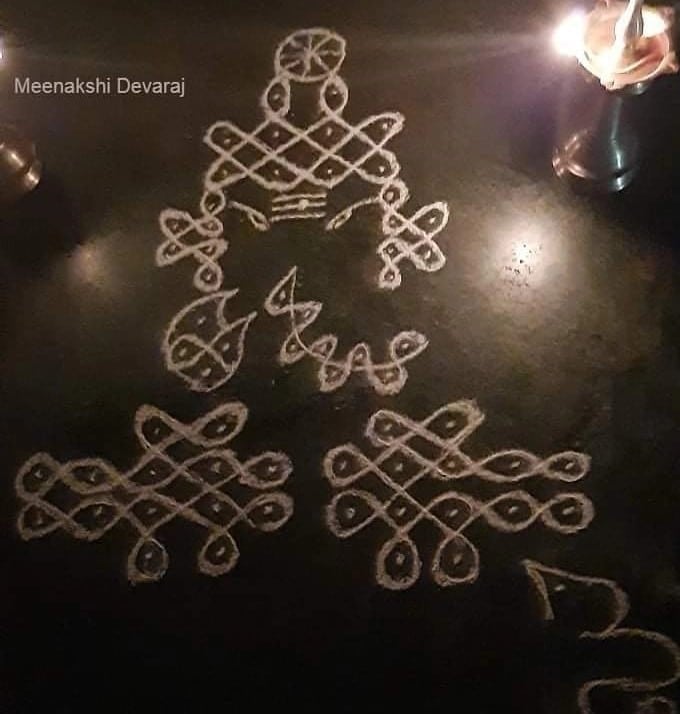
Kolam is one of the most popular art forms in South India. It is said that Kolam was created to please the goddess Mariamman, who is believed to bless all homes that are decorated with it. The designs can be complex and intricate, but they are not impossible to understand if you take the time.
Although not as flamboyant as the other Indian folk art, Rangoli, which is very colourful, a South Indian Kolam is all about symmetry, precision and complexity.
10 - Godna Painting (Chhattisgarh)
Godna Art or Tattooing has been a part of Indian culture for a very long time. It is popular in tribal societies as well as those in the North & Central regions. In Northern and Central India it is called “Godna” tattooing which was observed as being typical of primitive tribes groups.
Godna art is the term used to describe permanent ornamentation of the body with tattoos. It is mostly practiced in Chhattisgarh state of India. Godna art is regarded as a type of postmodern body decoration where one’s creativity can be expressed & displayed on their skin. Gonda, like other forms of tattooing, needs artistic dexterity and precision.
The main purpose of tattooing one’s body is to obtain acceptance from society. Sometimes tattoos are also done on areas of the body that are not readily visible. The art itself provides an ideal canvas for originality and self-expression, which is what everyone wants.
Tribal folks in the state also wear ornamentation which differs from their process and meaning. It is deeply rooted in their spirituality and belief. They believe ornaments are mortal and human made like humans themselves.
Tattoos are commonly used as permanent body decorations and often emblematic of a certain group or identification. The tribal women of Chhattisgarh, India decorate their bodies with tattoos called “Godna.”
Some tribal people have traditional tattoos. Tribal beliefs say that it’s often the only decoration that remains with a person after death. There are some interesting thoughts on why it started and some historians suggest.
Some believe that tattoos were used as a form of communication in ancient times and some say they were just decoration. While some say the purpose of the art is still up for debate, others believe it was exclusively about personal aesthetics.
The different designs and patterns on tattoos can act as identification marks that can tell you a lot about the wearer. Some of the patterns that are most popular amongst people are the cross, star, moon, and butterfly.
Girls generally prefer tattoo designs with flowers or geometric shapes on them, but young girls might find dots all over their face to be more fun. Girls also tend to choose a half-moon shape on their wrist that looks like a horseshoe.
Elderly women tend to get tattoos of scorpions, deer, peacocks or flower-like patterns on their hands, ankles or shoulders.
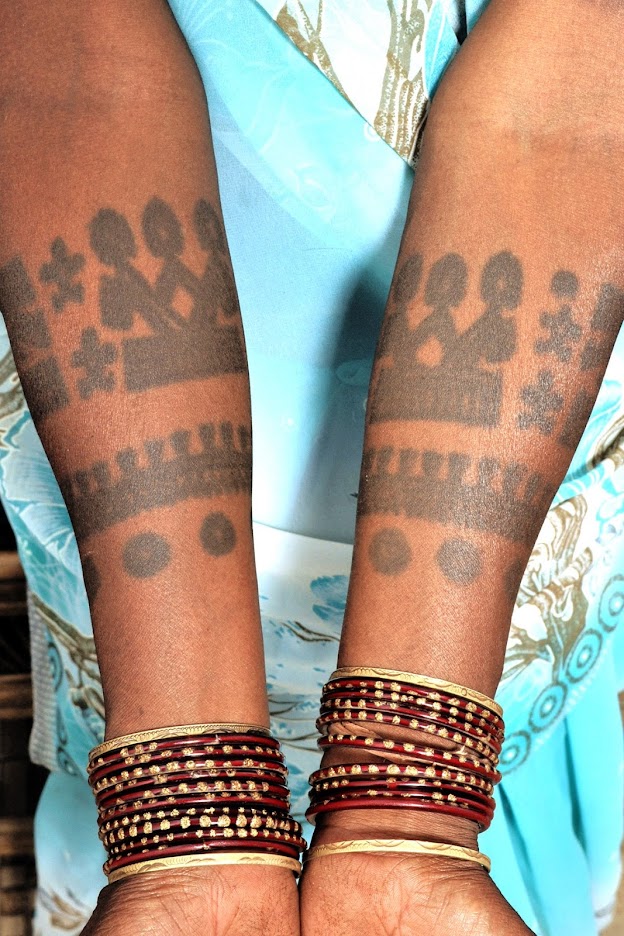
Even today, Indian society continues pre-historic rock art tattoos as its popular tradition. Noteworthy Godna paintings are found in the areas of Rajanandgaon and Surguja, Chhattisgarh. It can also be found in Dindori, Madhya Pradesh and Madhubani Godna of Mithila, Bihar.
Godna artists in Madhubani use natural colours derived from bark, leaf, flowers, and seeds to paint illustrations on the outside of their houses instead of depicting Hindu gods. Whereas Brahmins and Kayasthas design animals, minerals, and vegetables on their huts.
Modernization has had a significant influence on the Godna art and artists. Tattooing has shifted from body to paper, cloth and canvas. Female tattooists have played an important role in the dissemination of Godna painting in India and abroad through exports like textile materials for garments, prints for gift items, handmade sculptures, etc.
Source: Indian Culture
11 - Gond Painting (Madhya Pradesh)
Gond painting has been practiced by the Gond tribe of Madhya Pradesh, India. Generally painted with dots and dashes or short lines, their illustrations feature complex patterns.
A type of Mural painting, done beautifully on the walls and floors as part of festival celebrations. Primarily using natural pigments for colors from vegetables, flowers, cow dung or mud etc
Gondi culture is the main background for the designs and patterns selected. Gondi is an Indian tribe that lives in the regions of Madhya Pradesh, Assam, and Andhra Pradesh. The unique feature of Gond painting is the fusion of living creatures with nature, they all seem connected.
The story of Gond painting is not complete without mentioning young Gond Tribal Artist Jangrah Singh Shyam, who transformed these mural paintings to canvas and paper in 1981 and tragically passed away in Japan under mysterious circumstances at the age of 39, promoting Gond Art in Japan.
His style of Gond painting on paper and canvas is also widely known as Jangarh Kalam. Gond tribal artist Jangrah Singh Shyam, is a master of the Gond tradition. He creates contemporary art with natural materials such as bamboo and leaves. His work is on display in galleries and museums around the world including the Smithsonian Museum of Natural History in Washington D.C., and London’s Victoria and Albert Museum.
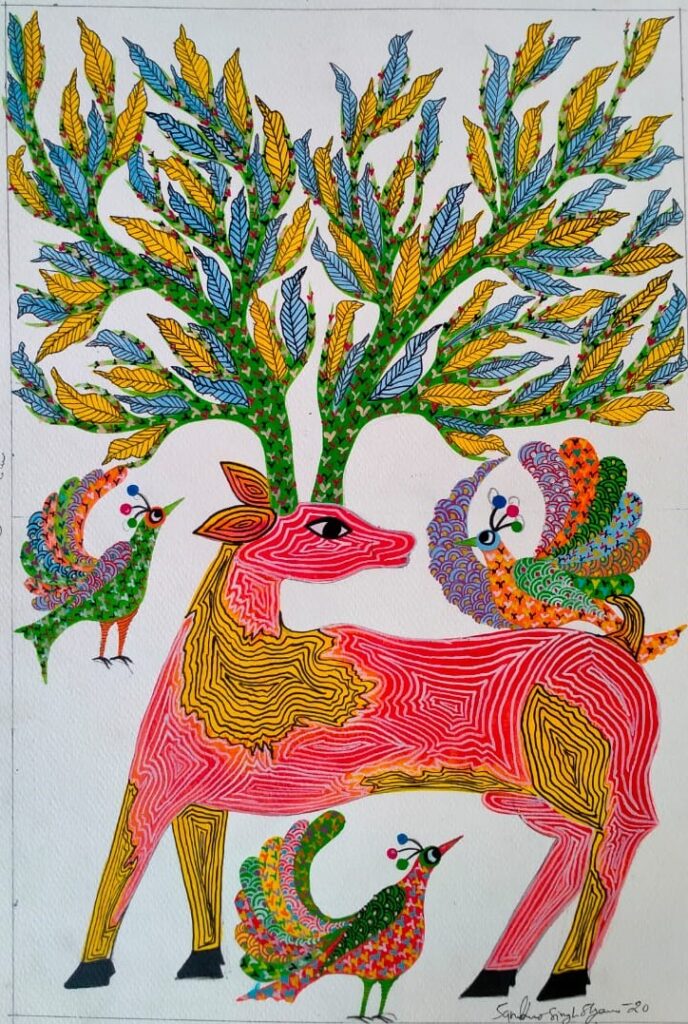
The subject of Gond Art is predominantly natural, with animals, trees and birds. The designs and patterns selected are based on Gondi culture.
12 - Jadopatia Painting (Jharkhand)
The Jadopatia painting of Jharkhand is a type of folk art that has been practiced in the Indian state of Jharkhand for centuries. The paintings are made with natural pigments on cloth, metal, wood, or leaves.
These are generally practiced by the Santhals, where artisans make scrolls called Jado or Jadopatia which are drawn with natural inks and colours. They are used to help people tell stories in the form of illustrations. They depict scenes from the faraway afterlife, beliefs in tiger Gods etc.
The Jadupatua paintings are vertical scroll paintings that were performed on cloth in earlier days but later these paintings were done on papers.
The scrolls of traditional horizontal scrolls were made into vertical scrolls and the length of the painting was then reduced to allow more than one scene to be shown. The use of color is very subdued and mainly limited to earth tones such as brown, yellow, and orange
Most ancient scrolls were made from waste paper. Since paper was then scarce, good quality paper wasn’t available. The scrolls were made up of sheets of paper that were either glued or sewn together and often wrapped in fabric so as to protect the scroll’s contents.
The scroll was secured with a string at each end. Pieces of bamboo were sewn in to act as rollers, so the scroll could be wound tightly around them.
Some scrolls were short and had two or three panels, while others could have 14 or more.
The scroll paintings were mainly prepared for Santal audiences by a Hindu painter caste known as jadupatuas and collected in the Santal Parganas.
The brushes used by the ancient Jadupatuas are bunches of goats hair tied to a small stick. Earlier, they were painted using natural colors made from vegetables or minerals.
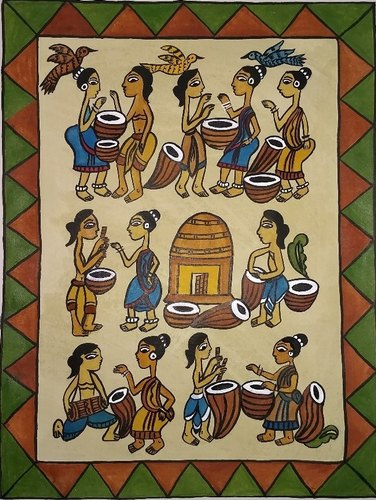
All paintings depicted figures in a single flat plane, with little attention to naturalism. The images are divided into panels that are separated by bands that span the length of the painting.
Easy-to-follow diagrams are outlined in basic shapes, with trees, flowers or rocks. They’re mostly depicted using a basic corrugated line that connects forehead, nose, lips and chin. The eyes were the only parts that were enlarged.
13 - Kalamezhuthu Art (Kerala)
Kalamezhuthu is a traditional art form that originated in Kerala. The art form uses the patterns of rice flour paste and water colours on a cloth to create elaborate paintings. The whole process of Kalamezhuthu is done by using the hands only and it cannot be erased or reused, which makes it an exclusive and exquisite art form.
‘Kalamezhuthu’ is a type of medieval Hindu art that was popular in the south of India from around 1750-1850. The word means ‘drawing pictures’, and pictures of gods and goddesses became the central theme.
A lot of religious art is done in the form of ritualistic drawings – for example, pictures of gods created by using coloured powders. It is believed that such depictions are there to ‘welcome’ gods.
The art form is accompanied by a long chant sung before the performance starts. It’s done on the floor, which is what gives it its meaning in this context. The artform sees all of Earth as one large canvas to paint on.
Kalamkari use natural colors from materials such as charcoal, turmeric, leaves and rice. White is derived from rice, black from charcoal, yellow from turmeric and green from leaves. Red can be made by mixing other colors.
During November & December, you can see Kalamezhuthu performances at many different Devi temples in Kerala. The maestros use coloured powder to create beautiful drawings of the Gods on the floor. Some of them include Bhadrakaali, Ayyappan, Serpent or Vettakkorumakan.
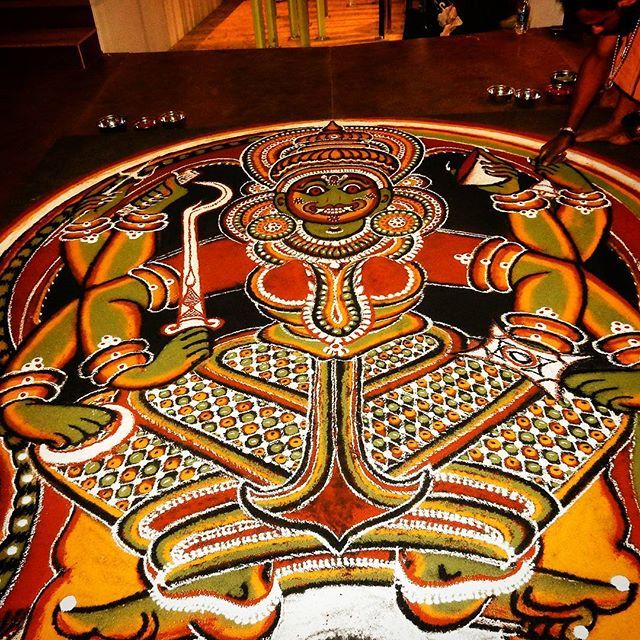
From temples to noble households, one sees these unique portraits accompanied by the Kalamezhuthupattu. These are erased at the end of the ritual, with the rhythms of various musical instruments like the ilathalam, veekkanchenda, kuzhal, kombu and chenda, acting as accompaniment.
14 - Kalamkari Painting (Andra Pradesh and Telangana)
The term “Kalamkari” is said to have come from two Persian words, “Kalam”, which means pen, and “Kari”, which means craftmanship. Kalamkari Painting became popular under the patronage of the Golconda sultanate.
Kalamkari is the Oriental word for the Indian village of Kalamkari where this type of hand-painted or block-printed textile was originally produced. Now, Kalamkari paintings are also made in Isfahan (Iran), Andhra (India) and Telangana (India).
Only natural dyes are used in Kalamkari, which involves 23 steps. There are two distinctive styles of Kalamkari art in India – the Srikalahasti style and the Machilipatnam style.
To create Kalamkari, the cloth is first steeped in a mix of buffalo milk and astringents. This is then dried under sunlight. Afterwards, the colors for red, black, brown and purple are outlined with a mordant before being placed on the cloth.
To dye a blue part of a cloth the next step is to cover other parts in wax and then immerse it in indigo dye. After the cloth is out of the indigo, scrape off the parts covered by wax and paint on any other areas needed. This time-consuming process is similar to Indonesian batik
To create contours for a design, artists use a pen which they created by attaching fine hair to the pointed end of bamboo or date palm. This is then soaked in a mixture of jaggery and water.
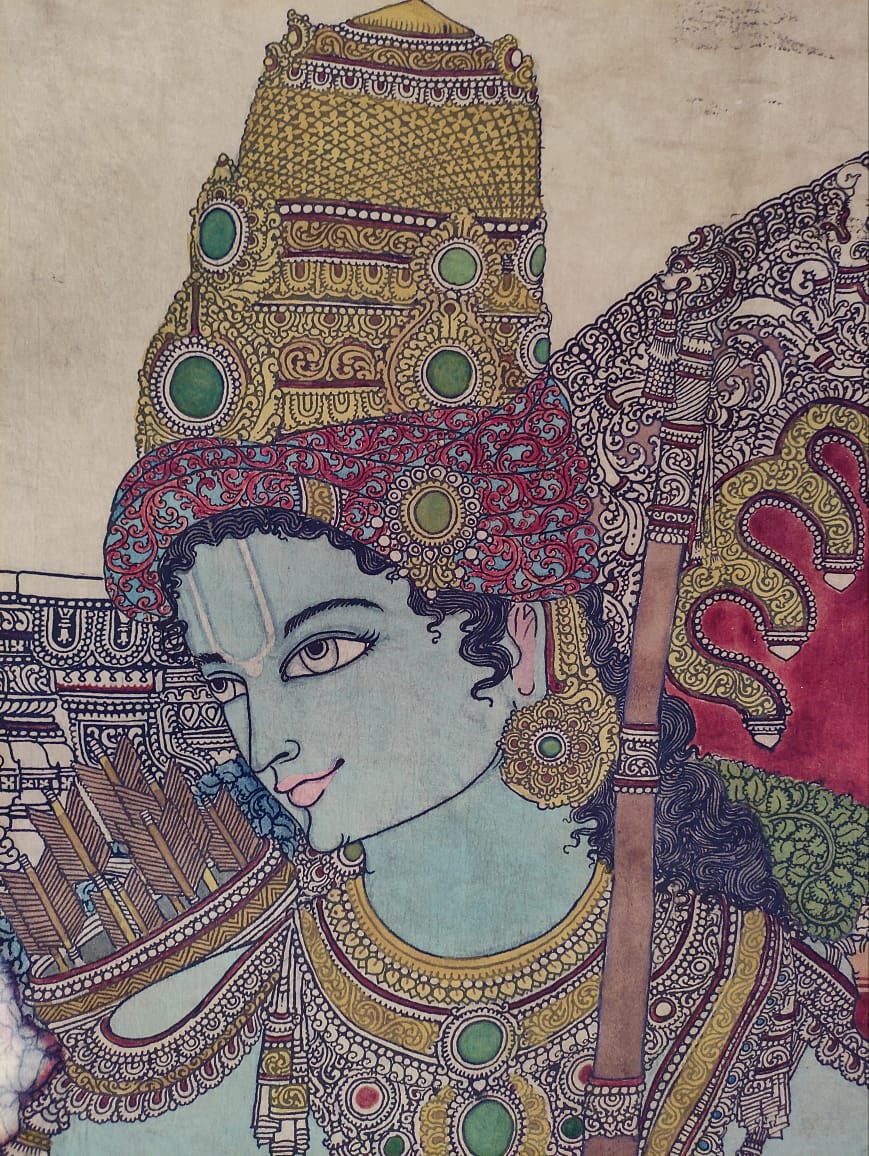
Kalamkari in particular depicts epics such as the Ramayana or Mahabharata. However, nowadays many pleasing figures such as musical instruments, small animals, flowers and the Buddha are also introduced thanks to modern technology.
15 - Kalighat Painting (West Bengal)
The Kalighat paintings are a tradition of religious art prevalent in West Bengal, India. The paintings of the Hindu goddess of the same name, Kali, are painted on cloth and can be seen on roadside stalls and shops. These paintings depict various scenes from Hindu mythology and people believe that they bring good luck and prosperity.
The Kalighat paintings originated from being items people would buy when they visited the Kalighat Kali Temple in West Bengal, India. The paintings have been around since the 19th century and have developed a lot over time.
The Kalighat paintings started off with illustrations of Hindu gods & deities, but quickly diversified to show a variety of topics from everyday life. In the 19th century, traditional scroll paintings were flourishing in Bengal. These paintings were popular in rural areas and were the only form of art that could compete with European styles.
These paintings were done on this kind of material. They usually depict the gods and goddesses as well as scenes from epics like Tulsidas’ Rama Charita Manas. The artists depicted medieval epics on scrolls and travelled around singing the stories to listeners. They were called patuas.
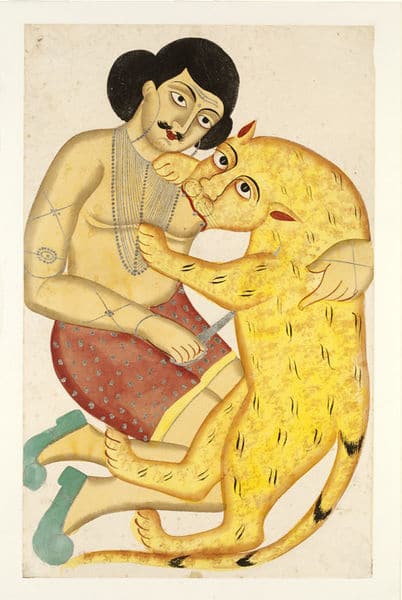
One of the many achievements in Kalighat painting is that they made simple paintings and drawings. These images were easily reproduced by lithography and then later hand colored.
This trend continued up to the early part of the twentieth century and these paintings ended up in museums and private collections. The charm of Kalighat paintings lies in the fact that they captured the essence of daily life, and influenced modern artists such as Jamini Roy.
16 - Kangra Painting (Himachal Pradesh)
The Kangra paintings are an art form of Kangra, India. It is said that the craft was born in the 17th century and it has been passed down from generation to generation. It is still practiced today at various places in and around Kangra Valley.
One of the most famous styles of Indian art, Basohli, died out in 18th century. However since then many paintings have been created in this style that helped it become more popular than the Pahari art.
This style reached its peak during the reign of Maharaja Sansar Chand Katoch (r.1776–1824) who was a huge supporter of Kangra art. The paintings he commissioned where large in size and fueled the work for others providing them with more commissions.
Maharaja Sansar Chand was an ardent devotee of Krishna and often commissioned artists to paint scenes from Krishna’s life. The main subject in Kangra paintings is Shringar (an romantic sentiment).
Kangra painting is most well-known for its graceful lines, bright colours and detailed décor- it follows a style similar to that of Ajanta.
This style of painting used a fine type of brush that was made from squirrel hair. In addition to using pure colors to paint the Kangra region, the colors have retained their vibrancy over time.
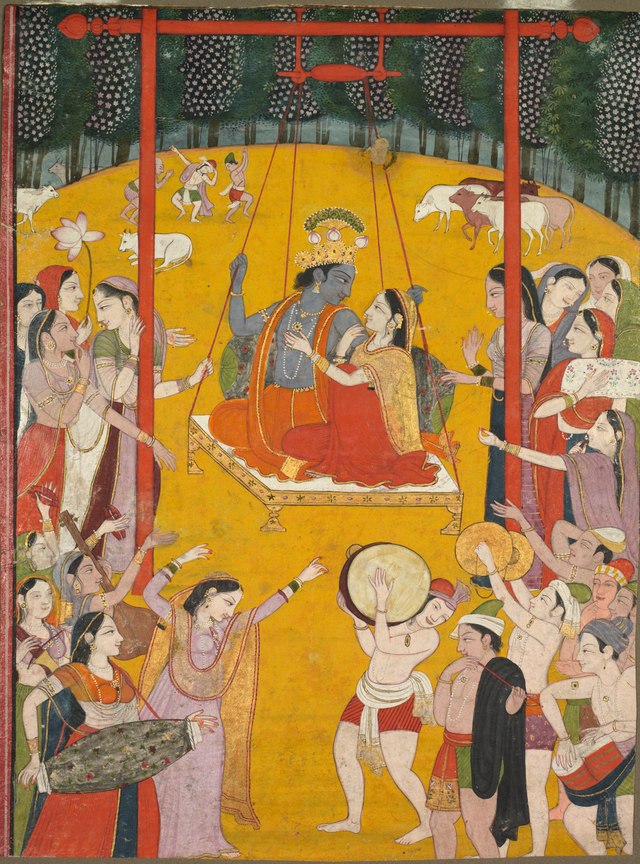
The subjects portrayed in Kangra paintings of that era reflect the culture and lifestyle of the society. Bhakti cult was at its peak, while Krishna-Radha love story had strong spiritual connotations.
The Kangra paintings which were influenced by the Bhagavad Purana often depicted scenes from Krishna’s life in Brindavan or the Yamuna river. The other popular themes included the story of Nala and Damayanti, and Keshavdas’s Baram.
17 - Kavad Painting (Rajasthan)
“The enjoyment of stories has been around since the dawn of civilization. We love listening to new stories, old stories, and especially ones about gods who punish the wicked.”
There are plenty of storytellers in the world and one form that stands out is a mobile storyteller, who carries beautiful stories in a colorful house-like structure. This is the kavad.
The Kavad is a portable wood-carved shrine that is traditionally used to house and worship Hindu gods and goddesses. They are usually beautifully carved and painted panels in a traditional style. The Kavad has been the prized possession of the Suthar community in Mewar for over 500 years, with several families claiming to be its originators.
Suthars are typically made from wood cut from the Neem tree and traditionally red was used as the color. However, over time this has changed to match customer demand.
The word Kavad probably comes from the word “Kivaadh” which means door. It can after-all be seen as a collection of doors or doors that open the layers of a story.
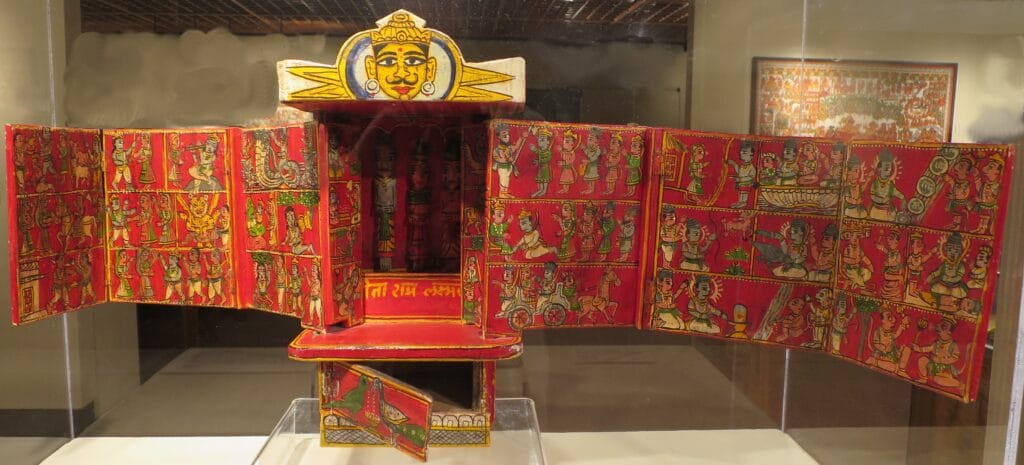
In another context, it is also used for ‘carrying on the shoulders’. Remember the Kavadiyas who carry the water of Ganga to their village temples.
The Kavadiya Bhat from Marwar takes it and brings it to his patrons’ houses in Rajasthan. The storyteller opens the multiple panels one by one and recite lores and stories spread across various subjects. The art of this traditional art form is on the verge of extinction.
It is believed that audiences become pilgrims as they listen to the sermon and follow along the story the priest tells.
18 - Kerala Mural Painting (Kerala)
Kerala Mural Paintings are one of the most well known and distinctive forms of art from Kerala, India.
The Kerala mural paintings are a form of temple art that have been practiced in Kerala for over 2000 years and has been preserved through generations by local artists. Although they have been influenced by western techniques, they have retained their Indian roots.
They have a close connection to the daily life of the people, and express the religious and cultural traditions of Kerala. The art form can be seen in religious & cultural traditions of Kerala, and depicts scenes from the traditional Puranas as well as daily life of local people.
They can also demonstrate an individual’s inner conviction, confidence in their beliefs, traditions & customs. Kerala’s own style of murals has been seen in the Thirunadhikkara Cave Temple and Tiruvanchikulam. These murals have been dated to around 400 A.D.
A mural is a large painting on a wall that often depicts a story. The word is the Latin word for the word ‘wall’, which correlates with them being painted on either side of a wall. It is painstakingly prepared prior to being painted.
Traditional murals are painted with five colors, which are red, yellow, green, black and white. These all traditionally come from natural substances that the painter has on hand. Red, yellow and white paints were traditionally made from two sources: red laterite and white lime. Black paints were the result of oil-lamp soot deposits.
Three of the most popular mural pieces in Kerala are: the Shiva Temple of Ettumanoor, Ramayana murals from Mattancherry Palace and Vadakkumnatha Khatam.

Mural artisans in Kerala were heavily patronized by various rulers, but they thrived more during times of Indian rule. However, under British colonialism this art form suffered considerably.
After India gained independence in 1947, murals had less stigma. Since then, they have been on the rise in temples in Kerala. The Centre for Study of Mural Paintings is a school established in the Thrissur district of Kerala by the Guruvayur Dewaswom Board under the chief instruction of Mammiform Krishnan Kutty Nair. Representing revival of this art form.
19 - Kishangarh Painting (Bani Thani) (Rajasthan)
Rajasthani paintings are divided into different schools, one of which is the Kishangarh School of Art. Kishangarh Painting is a style of Indian painting that originated in the city of Kishangarh, India.
The school has a distinct appearance with a religious atmosphere. The facades of the buildings were aggressive and distracted from the sublime, while because of their delicate form, they responded to female heads with strong facial features that were drawn in a very different way from previous generations.
Artists of Kishangarh created beautiful, intricate miniatures under the rule of Maharaja Savant Singh, the 18th-century Rajput king. He was a devotee of Krishna and this influenced his rule. Therefore, most paintings were based on the romantic stories of Krishna and Radha.
The Radha Krishna in these paintings were, in fact, used to represent Maharaja Savant Singh and his mistress and later his wife, Vishnupriya. The paintings are titled “Radha Krishan” because they depict the story of their love.
Maharaja Savant Singh’s mother employed Vishnu Priya as a court singer, after she charmed him with her beautiful singing. The desire to spend time with Vishnu Priya grew into love, and they got married in 1740.
As the wife of Maharaja Savant Singh, Vishnupriya adorned herself with exquisite makeup to represent her royal stature. She became known for her elegant style which she displayed through her makeup and other accessories.
Bani Thani, which is a Mughal miniature painting, has been speculated to be the influence behind Kishangarh facial types.
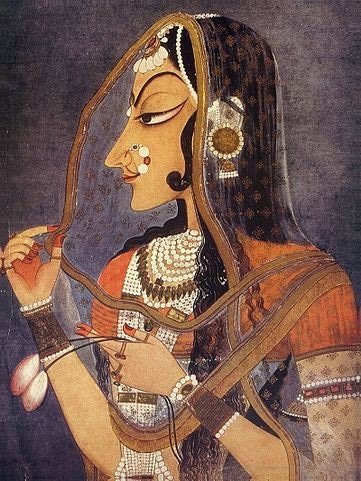
It is frequently shown to occur in panoramic landscapes. King Savant Singh was impressed with her beauty and had his favorite artist, Nihal Chand, paint her portrait.
This is a close-up side profile of Bani Thani. She has thick, arched eyebrows over her big lotus eyes. Her nose, chin and jaw are all prominent features on her face. These features represented an ideal woman’s beauty at the time, a symbol of elegance and grace.
Bani is also wearing her Rajasthani bridal costume & jewelry. She has an old-fashioned veil or scarf, decorated with gold and pearl accents across the front. These will cover half her face like a veil.
The veil in the painting is a cultural symbol of a woman’s modesty and honor. It has been used for that purpose in many cultures across history, including in India, where it was seen as the Rajput’s family’s never-ending honor to defend womanhood. Bani Thani is shown holding lotus buds in her hand, which represent her purity. Lotus buds are considered to be the equivalent of the goddess Radha’s purity.
20 - Kondapalli Bommallu (Andra Pradesh)
Kondapalli Toys are made from wood and are from the Indian state of Andhra Pradesh.
Wooden painted toys from Kondapalli are famous for their finely crafted figures of animals and people. The wood is locally sourced and adds a touch of aesthetics to rooms with their spindly figures. These toys have carved out a niche of their own in the world of handicrafts.
Artisans with nimble fingers carve wooden characters with aplomb, as the characters emerge from light soft wood. The wooden piece is heated to make it moisture-free. For each part of the carving, a different carved design is made. The sections are then glued using an adhesive obtained by crushing tamarind seeds.
The traditional craft of crafting remains popular and is an important way for many people to earn a living. Craftspeople, known as Aryakhastriyas, who form the ‘Nakarshalu’ family and weave these yokes were mentioned in Brahmanda Purana, which was compiled over 400 years ago.
The artisans are said to have migrated from Rajasthan in the 16th century to Kondapalli and claims their origin to Muktharishi, a sage endowed with skills in arts and crafts by Lord Shiva.
Water colours and oil pastels are the two different types of materials typically used to paint toys or figurines. The paints may be applied with a soft and thin brush made from goat’s hair.
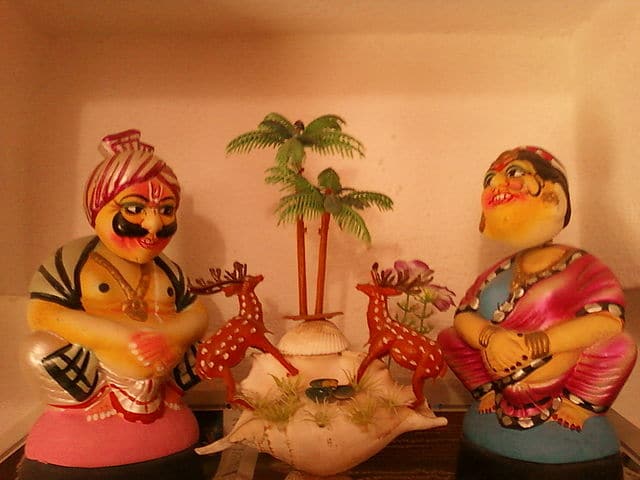
Collection at this heritage museum in Andhra Pradesh is of the best in the world. Apart from toys, there are other items depicting scenes from Hindu mythology, rural lifestyle etc.
Kondapalli Toys, based in India, is locked in a battle for market share against the competition. They are not only competing with other Indian toy manufacturers but also against Chinese machine made toys which can be manufactured much more cheaply.
21 - Kurumba painting (Tamil Nadu)
Kurumba painting (Tamil Nadu): Kurumbas are one of the five communities which occupy various altitudinal zones of the Nilgiri ranges, the Kurumbas are believed to be the descendants of the Pallavas.
These Indigenous tribes are known for their healing power, hunting skills and knowledge of medicinal plants.
In subject, the Kurumba art style is quite similar to the Warli and Saura folk painting styles. The key difference between these three is in their style. Whereas both Warli and Saura depict elaborate figures, a Kurumba artwork has a cleaner geometric style.
The Kurumba painting is characterized by its concentric arrangement of colours. It features more than three colours
The figures in the paintings seem to be dancing even though they are most likely performing different tasks. Consider the level of detail in how they are drawn.
The figures featured in the painting are recognized by their bunned hair. One group is known as the Warli and the other, Saura. These two groups have two bodies but these figures only feature one almost rectangular shaped body.”
Unlike the other folk art of Warli and Saura, animals are not often seen in Kurumba paintings. This is quite different than these other two forms of folk art which contain a lot animal imagery. Animals help to keep villages safe from harm. So, it is possible that this lack of animals in their art is representative of the role they play. Animals like elephants and deer are often shown to be grazing in the background
Natural colors obtained from leaves and tree resins are traditionally used for illustrations in the Kurumba art form. Artists traditionally use red, mustard, black, and green.
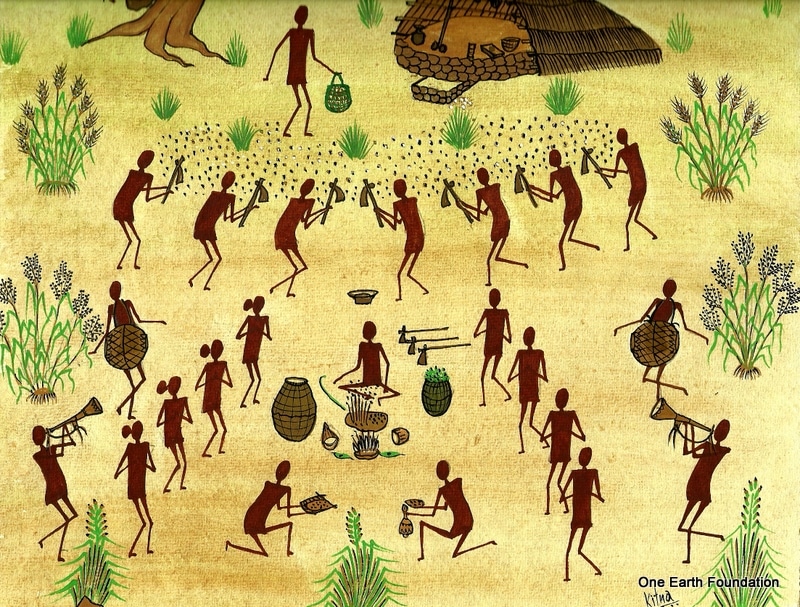
These are obtained from the bark of trees or from the leaves of plants. The tree resin and leaves are mixed with red and white mud varieties. A piece of cloth is used to apply colours onto walls built using cow dung.
In the past, rock surfaces, the outer walls temples and houses were used as the canvas for painting. Today, the artists use watercolor on handmade paper
Krishnan is believed to be the only surviving Kurumba art specialist from his community.
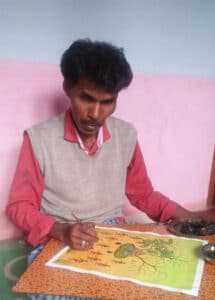
The C P Ramaswami Aiyar Foundation introduced the art to the outside world, but Krishnan had to maintain it with no financial assistance whatsoever. The family sold their ancestral property to make ends meet. They also found themselves in legal battles with other claimants for ownership of traditional paintings.
Source: Deccan Herald
22 - Kutch Lippan Art (Gujarat)
The Kutch Lippan Art is a form of art that originated from the Kutch region in Gujarat. This form of art is a result of a fusion of the traditional Kutch crafts with British and Indian techniques.
Lippan art is a traditional craft native to Gujarat. The mud and mirror work features materials such as clay and the dung of the local camel population, which allows for an interesting effect that keeps homes cool.
Though they’re originally from Kutch, these scintillating murals can be found on the outer walls as well. You can notice these murals on both exterior and interior walls. They provide a type of beauty to a generally harsh way of life in the region.
Women from the Rabari community are typically in charge of mud and mirror work. They don’t trace or draw a pattern before beginning the work. This has made them especially skilled at this art form.
Rabari is the pastoral community from Kutch who live in villages. They live in houses called Bhungas which are designed to accommodate their practical needs.
This art form has a hoary past as no records are available to trace its origin. Various communities in Kutch do mud-washing in their own distinct style.
A common practice in Kutch, India is the art of mud-washing. Mud-washing is an ancient form of folk art practiced by various communities around the world, but the origins of this particular art form are unclear. Various communities in Kutch do mud-washing in their own distinct style.
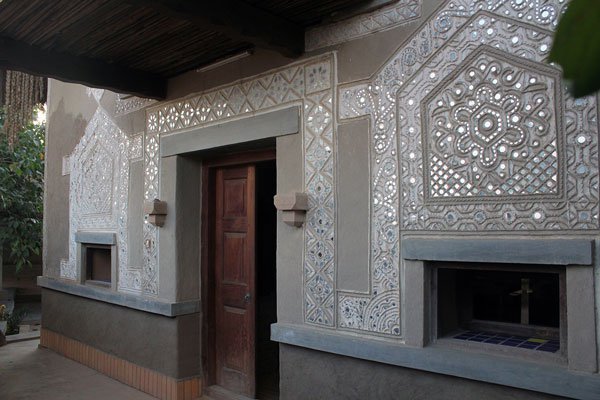
Artists/craftspeople in the Muslim community practicing this form of art tend to stick to geometric patterns. Depicting the human or animal form is considered deeply inappropriate.
Mud mirror work has gathered attention from the modern world for its intricate pattern and aesthetic perfection and has made a full transition from its unknown, modest stature to the mainstream art world, decorating the walls of urban homes.
23 - Leather Puppet Art (Andra Pradesh)
Andhra Pradesh is famous for its traditional leather puppet art and craft. The leather puppets found in this state hail from the traditional folk and cultural expression of the region, known as Leather puppetry.
A traditional form of shadow puppet theatre practised in Andhra Pradesh, it is known as tollubommalu or tollubommalatta. The name is derived from the Telugu word for leather, tollu and dolls or figurines, bommalu.
Leather puppets are usually made out of pieces of hide or stiff parchment, which are colored to make them bigger & heavier. They are more colorful & better-looking than similar craft work from other regions of the country.
Certainly not the only form of performing arts in India. Works in shadow puppet theater often relate to themes in Hindu epics like the Ramayana and the Mahabharata–culture is deeply connected with religion.
Places like Nimmalakunta in Ananthapur district, Narsaraopet in Guntur district and D.C. Palle in Nellore district are considered the main centers of leather puppet industry in Andhra Pradesh. Artisans in these places believe that theirs is a hereditary profession. The variety of people who participate in this form of craft is mostly the Marathi-Balija culture.
Creating a shadow puppet traditionally takes around 30-40 days. The amount of time required will vary depending on the complexity of the puppet.
The first step of this process is to buy fresh goat hide from the weekly meat market. Next, it should be soaked in cold water for 2-3 hours before it can be cut and flattened with a heavy object like a hammer. To create leather, the animal’s skin is washed in warm water and dried in the sun. Once it is dry, it must be cut according to product requirements.
Goat skin is processed into the delicate, translucent parchment used in the creation of traditional puppets. The curing, washing, and cleaning process can take many months, but once completed an artisan will use a stylus to draw the outlines of the characters. Once finished drawing all distractions are removed from the surface through carving or scraping, leaving just a clean white sheet for ink.
Holding the little windows up to the light makes the details of the puppet more visible. It also creates a glistening effect that makes it look visually appealing.
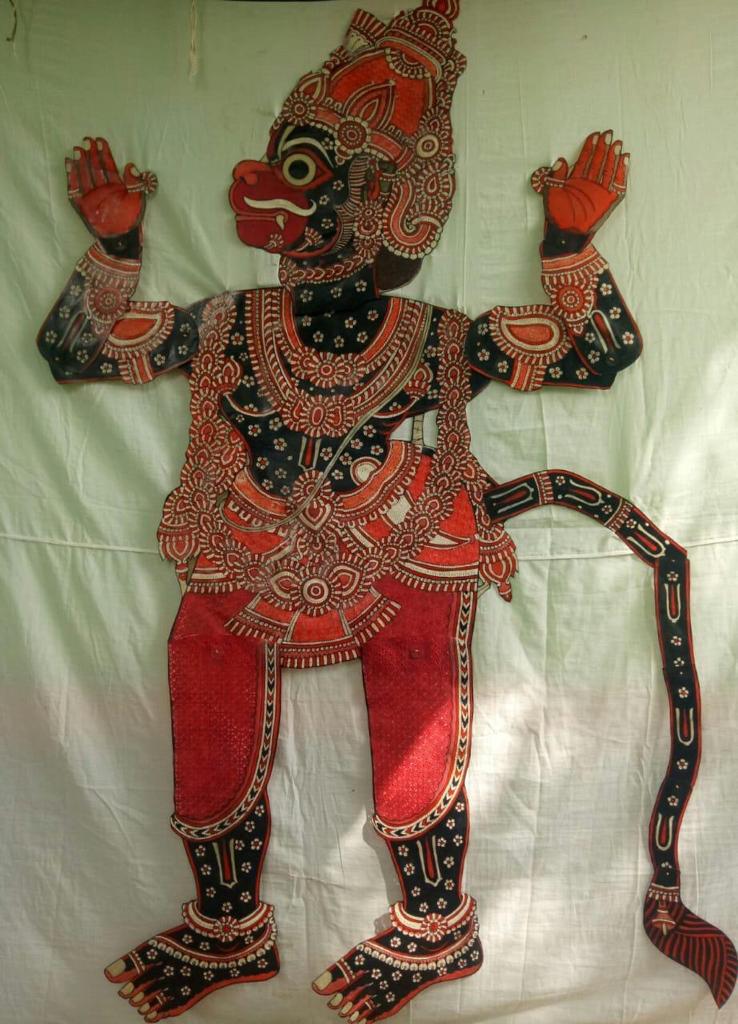
Once the design is cut out on the hide, it is outlined with blank ink using a bamboo nib. Holes are punched as embellishment at this stage. The outlines of the figures are painted in black with the help of a bamboo nib. Thin strips of bamboo are sharpened at the edge to create a nib-like shape.
Once the figure is outlined, it’s then coloured in vivid colours, such as red, green and ochre. Ink is used as a colouring agent and is applied with a brush. After marking up the outlines, different colours are filled into the main form. This requires painstaking precision and a considerable amount of time.
While black, red and green are some of the common puppet colours and female characters and sages are usually yellow, once the puppets’ colours have been applied, the outlines on them are then drawn back in black.
Leather puppet shows used to be incredibly popular in the past, until people started moving to urban areas. They played a significant role in society, educating & entertaining the rural masses by telling stories & providing lessons on Hindu mythology. TV’s arrival slowly made this art obsolete.
It is true that this art of weaving is on its last lap. However, many families of weavers who had their livelihood dependent on this unique art have started to switch to other handicrafts. Now they’re making wall hangings, lamp shades and other home décor artifacts out of animal hair too. You will find that the new generation is not interested in continuing this tradition. They are looking for another way to live.
Approximately 20 families in Nimmalakunta village are involved with the manufacture of Chitrakaras while a few have transitioned to individual farming.
24 - Mandala Art
Mandala is a Sanskrit word that can translate to “circle” or “discoid object.” These geometric designs have deep symbolic meaning in Hindu & Buddhist cultures.
Mandalas are representations of various aspects of our universe which are used as instruments of meditation. They are also symbols of prayer, most notably in the East Asian countries, China, Japan and Tibet
Around 560 BC, Gautama became increasingly aware of human suffering and left his kingdom in order to attain enlightenment through meditation and thoughtful action.
Buddha preached his philosophy across parts of India and established the first sangha, a Buddhist community of monks. According to legend, Buddha began preaching his philosophy across parts of India, where he attracted followers and eventually established the first Buddhist community of monks.
We first learn about mandalas through the travels of Buddhist monks who shared practical, moral pursuits with others. Through them, it spread to other Asian regions including Tibet, China, and Japan by the 4th century.
The use of mandalas in Buddhist, Hindu, and various other religions is documented. Some painters of the spiritual craft were pious individuals who were commissioned for their work by a patron. They worked seated on the floor with a painting propped on their lap or in front of their crossed legs.
Hinduism and Buddhism have a tradition whereby one progresses towards the mandala’s center, which is believed to be filled with radiating joy. The mandala consists of concentric labyrinths enclosing the symbol of an object seen as supremely meaningful.
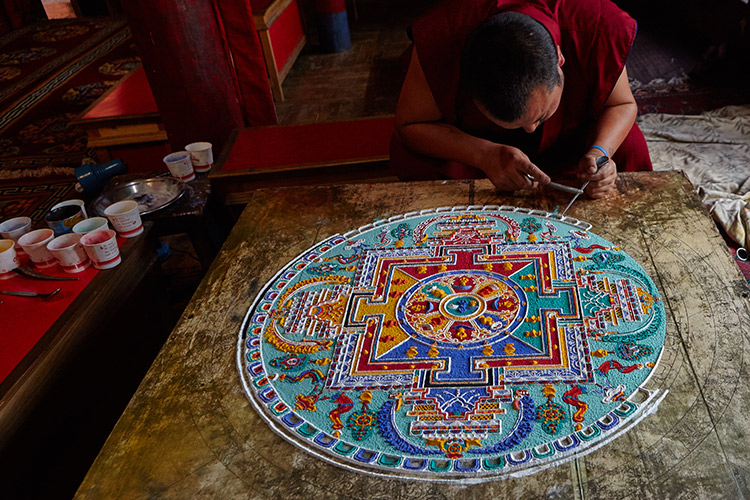
A mandala is a circular design, usually contained within a square frame. They can be put together in sections, with a central point of organization. One of the most common things to make with a mandala is a yarn or thread outline on paper or cloth.
Pretty cool to look at, often used as meditation aids. Some mandalas are created to represent specific beliefs or ideas.
Mandala is a spiritual and ritual symbol in Asian cultures, which can have two meanings: externally, it is seen as a direct representation of the universe; internally, it is seen as road map for deep meditation techniques.
25 - Mandana Art (Rajasthan)
Mandana Painting is a type of tribal art that has become popular in recent years. It has been around for centuries and used by traditional Meenas people.
Respect to writing records, the origin of Mandana paintings can be traced back to the Vedic age, 1500 to 500 BCE. Resembles with the design found in Mandana art and its relationship with color & symmetry are well-known. The lack of recorded evidence is replaced by theories that state Mandana paintings’ origin can be seen in its similarities to other recordings.
Vastu purasha mandalas are altars of Vedic pujas and the architecture of ancient Vedic temples. The core beliefs of drawing mandala paintings and art on the walls and floors are to welcome divinity into the house and keep away from evil forces.
“Mandana” translates to “drawing” in the language of Gujjar Bhakha and may also be derived from “Mandan”, which means “decorate.”
The making of Mandana paintings is a unique process, which marks the beginning with clay and cow dung. Traditions and cultures are then integrated into a simplistic painting that is both attractive and eye-catching.
The brushes used for this artwork are made from a combination of twigs, cotton & squirrel hair. Local paint colors consist solely of red & white, which is what makes them unique. Their source is chalk or brick that can be found in abundance in the region.
Prior to painting, the ground is typically mixed with cow dung, which then is combined with some red ochre or lime powder. This will then be drawn into lines & patterns using a tuft of hair or brush made out of date leaves.
The design of this painting may show scenes from life in Nepal, such as scenes from homes and daily life, Ganesha and other religious scenes, and paintings in the Hindu temple.
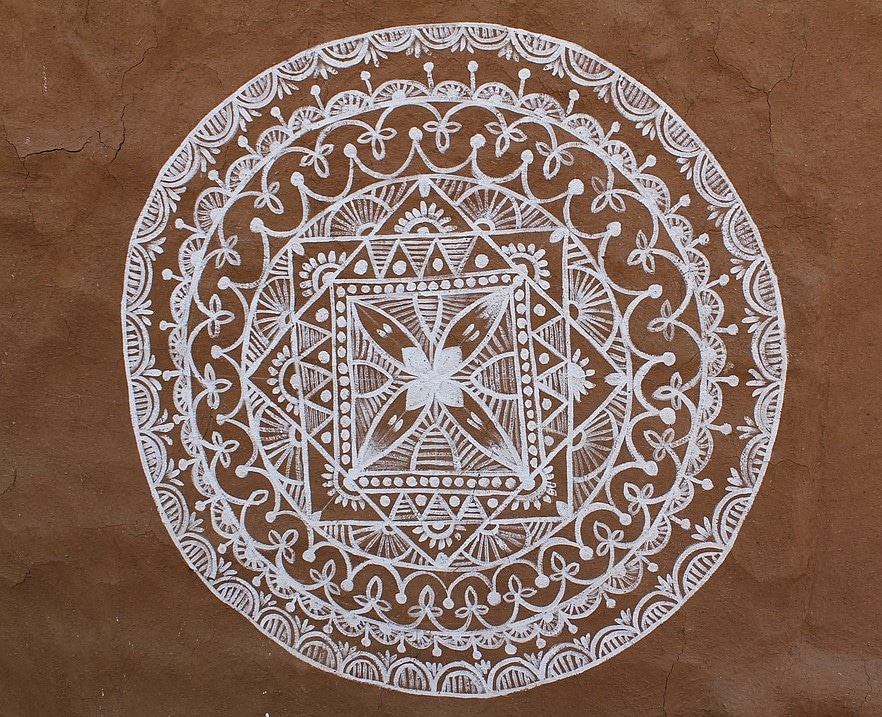
In most Mandana paintings, females are the ones who take on the role of painters. This is due to the tradition that females monitored their family & home.
It is believed that painting Mandana during festivals is a symbol of happiness, prosperity, and health.
26 - Madhubani Painting (Bihar)
Madhubani painting, also known as Mithila painting is a traditional Indian folk art that uses geometric patterns, contrasting colors & line drawings.
The painting dates back to the time of Raja Janak, a king in a Mithila. He had a daughter named Sita who was married to Lord Ram. To celebrate her wedding, Raja Janak asked his subjects to decorate their city in beautiful ways.
In the recent years, artists have been painting murals with geometric patterns on walls all around the city. They depict some rituals of weddings, births and celebrations.
Historically, Madhubani painting was passed down from generation to generation in the family of Mithila Region. The five distinctive styles are Bharni, Kachni, Tantrik, Godna and Kohbar.
Madhubani paintings are always two-dimensional and come with no empty spaces, usually filled with drawings of flowers, animals, birds, and other geometric designs.
These paintings are traditionally produced on freshly plastered wall surfaces or floors of huts, but now they are also created on cloth, handmade paper or canvas. The paste required to make them usually contains powdered rice.
This painting is created with a variety of tools and naturally-made dyes. It features colourful geometric patterns which are pretty eye catching, so it’s easy for anyone to see.
Different cultural occasions & festivals often have their own associated rituals, such as Holi or Surya Shasti. Some of these can include Kali Puja, Upanayana and Durga Puja.
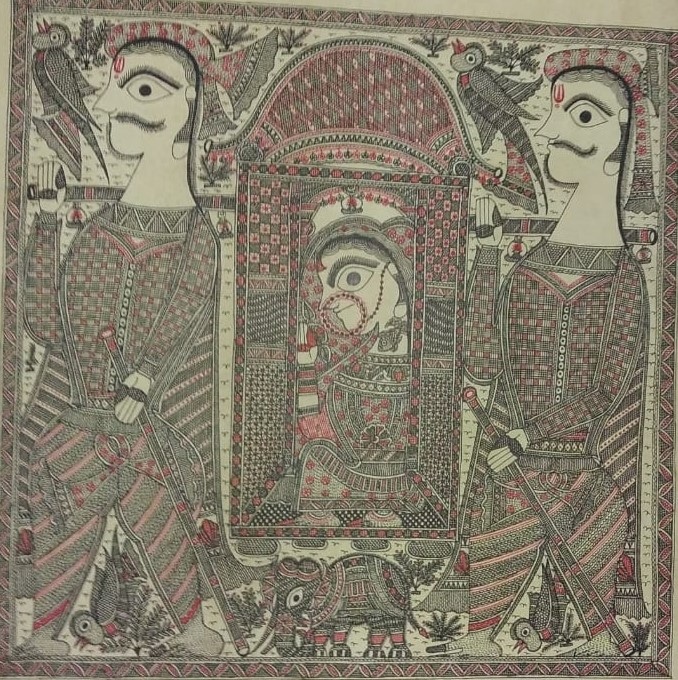
Madhubani paintings often depict scenes that reflect a connection to nature or religious ceremonies. Marriage is often depicted as a ritual called kanyadaan in India.
Natural objects like the sun, the moon, and tribal plants like tulsi are often painted in traditional art with scenes from daily life.
You’ll find wedding ceremonies in paintings alongside royal court scenes in most traditional work. There’s never a blank space left – it’s all filled up with flower paintings or other kinds of compliments to the previous work.
27 - Mata Ni Pachedi (Gujarat)
‘Mata Ni Pachedi’ literally means ‘behind the mother goddess’ and was worn as a draping that constituted the temple of worship for her. These textiles are sacred and act as a backdrop for daily rituals.
Mata ni Pachedi is also called the Kalamkari of Gujarat because of its resemblance to the Kalamkari art of South India, which is also done with a pen made of bamboo.
The story goes that when the nomadic Vaghari community from Gujarat, who worship Mata, were not allowed to enter temples, they instead created their own places of worship with illustrations of the Mother Goddess (Mata) on pieces of cloth.
Devipujaks are landless labourers. Their main livelihood comes from stone-cutting work or selling cattle, goats, vegetables and datan-twig toothbrushes. Their main deities are Meldi Mata, Kalika Mata, Khodiyar Maa and Bahuc.
The Vaghris also believe in animal sacrifice for various rites where the consumption of meat and alcohol seems to be culturally accepted.
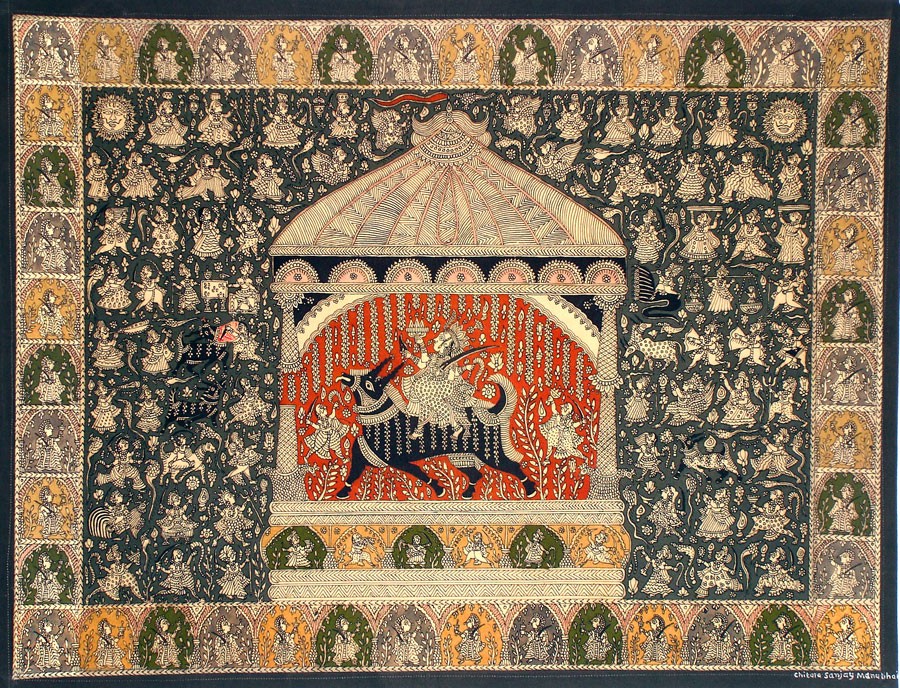
The original style of tie-dye only used two colors – black and red, made out of natural dyes. The artwork on the fabric is mainly about nature and artistic creations with light, animals and patterns all around.
Traditional pachhedis & chandarvo are hand-painted & hand-printed. They can be rectangular and can contain human figures of the purvaj (ancestors).
Devi worshippers or other narrative themes with the mother goddess seated on her vahana in the centre without her consort.
Mother Goddesses is represented in her five Vahanas (vehicles), Khodiyar mata (crocodile), Bahuchara/Becharaji mata (cock), Vahanvati mata (ship), Meladi mata (goat), Dashama (camel)
28 - Masan Painting (West Bengal)
Masan Painting
You are no doubt aware of the Hindu festival of ‘Masan Pooja’. This is still practiced by the Rajbanshi tribe, particularly in North Bengal. They believe that Masan Devta exists as a ‘rudra’ god. This might seem at odds with other Hindu celebrations but it should be done nonetheless.
That’s why people suffering from this think that ‘Masan Devta’ is responsible. They go to the occultists who sometimes scare the spirit away, other times drive it away.
The history of Masan deities is linked to the spread of ancient Buddhist religion of Tibet. They were neither considered as gods or demons and they were meant for worshipping near crematoriums.
The word ‘masan’ is derived from the word ‘shashan’ in Bengali. An ethnic group-the Rajbonshis are the main patrons of this art form that they call masaņ chitrakala.
The early representations of the Masan deities were rendered in silk paintings that resembled Tibetan thangkas or paintings on cloth. They were said to have healing powers and the Masan paintings were often used for treatment.
Since the closing of the Silk Route in North Bengal, Tantrik Buddhism has lost influence and is now limited to Jalpaiguri, Darjeeling & Coochbehar.
Nowadays, the regional deities of Masan are made out of cork, even though they still maintain their bizarre and frightening looks.
The craftspeople who paint the ribbons are called malakar (garland makers). They make different patterns and structures with shola (a wild plant).
They’re proud of their heritage and express it through the use of handmade brushes and natural pigments on shola motifs, which have special importance to Rajbongshi people.
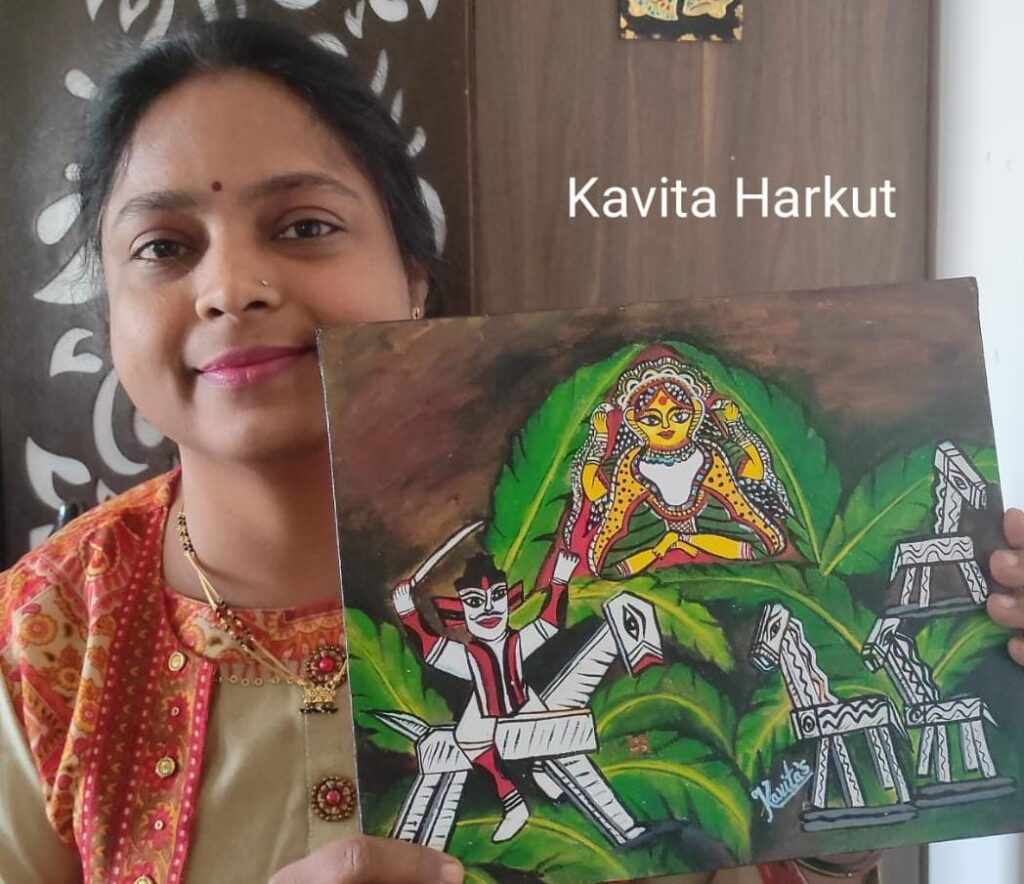
29 - Meenakari Painting (Rajasthan)
There was no tradition of metal work in India before the Mughals. Many centuries ago, a Mughal ruler known as Raja Man Singh brought skilled artisans with him from Lahore and set them up in Jaipur.
The Meenakari work in India is a tradition with a long history. The art form originated from Rajasthan. Subsequently, Meenakari work took roots in India and Jaipur went on to become the hub of Meenakari work in the country ever since.
Meenakari is a technique that takes a lot of skill to do. It’s performed with a metal object that’s attached to a lac stick & then detailed designs are etched or engraved into it. This leads to creating intricate pieces of art.
Enamel dust of the desired color is poured along the design and the groove’s heat melts the enamel to a liquid form. This process is repeated again and again with different colors until a final product is created.
Generally, white is laid down first and red last. After the final color has been fired it is cooled and buffed with agate to add depth. The underlying different colors determine how light plays off of the object.
Both silver and gold are used as a base for Meenakari. Silver work the best with enamel because it’s a softer metal. But modern day Gold enamel is more popular because of its durability and long life span, especially when exposed to regular wear-and-tear or damage from heat or chemicals.
However, Meenakari work can be found on a wide range of metals like gold, silver and copper. The latest addition is white metal.
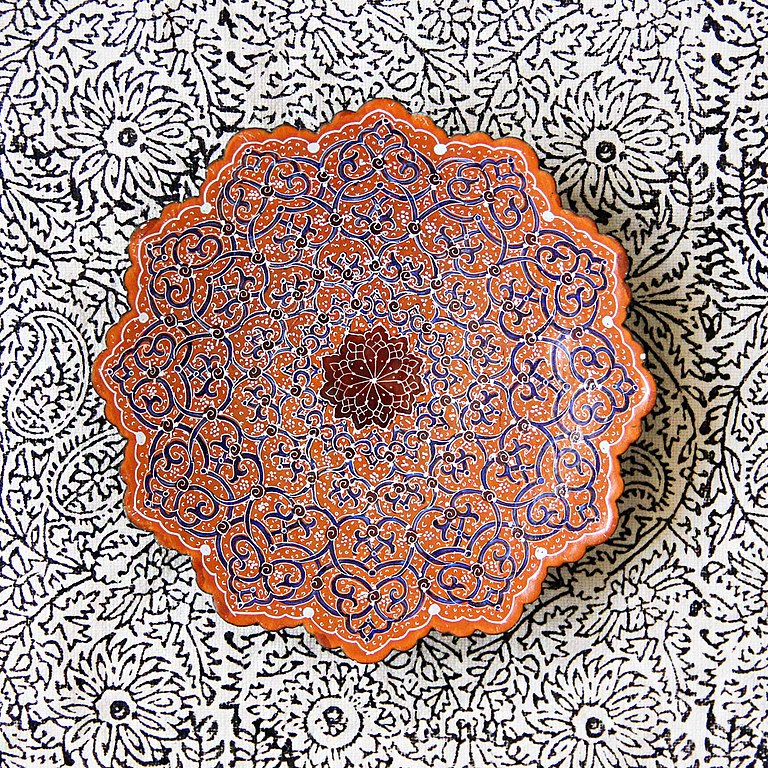
Jaipur is known as the center of Meenakari because it often uses Mughal colors to create its art. You can find items you need that have a red base to them, and they command a fancy price for their beauty.
30 - Mysore Ganjifa Art (Karnataka)
Ganjifa is an ancient Indian card game that was popularized during the Mughal era. Ganjifa cards are believed to have arrived in India through Persia, then widespread across Europe before settling in India.
Ganjifa used to be called “Ganjifa” in Persian, and that means cards. The word Ganjifa is derived from the Persian word ‘Ganj’, which refers to money and treasures. It was a common, leisurely practice for the aristocrats to involve stakes in the game. Mysooru Ganjifa was extensively patronized by the Mysore Royal Family.
One theory is that the Indian game of Kreeda Patra was renamed Ganjifa when it was brought to other parts of the world. This is because Kreeda Patra is, in fact, an Indian card game. While it has been popularly played in the Telangana and Andhra regions of India for centuries, it’s only recently gained popularity around.
However, under the Mughal rule during the 16th-18th century, Kreeda Patra cards became much more elaborate and grew in popularity. These cards were renamed Ganjifa and ultimately became a royal amusement for this period of Persian and Arabic influence in India.
Ganjifa became popular under the rule of Maharaja of Mysore, Mummadi Krishna Raj Wadiyar, and is sometimes also known as the “Mysore ‘Chada’ Ganjifa” type.
King Akbar helped to create Ganjifa as a specific board game and to promote its integrity. He encouraged various variations of the game, and artists in his court contributed by designing them.
Since the aim of the game was to teach, learn & tell stories from scriptures, all 18 games in this style are based on Purana’s, Ramayana and Mahabharata.
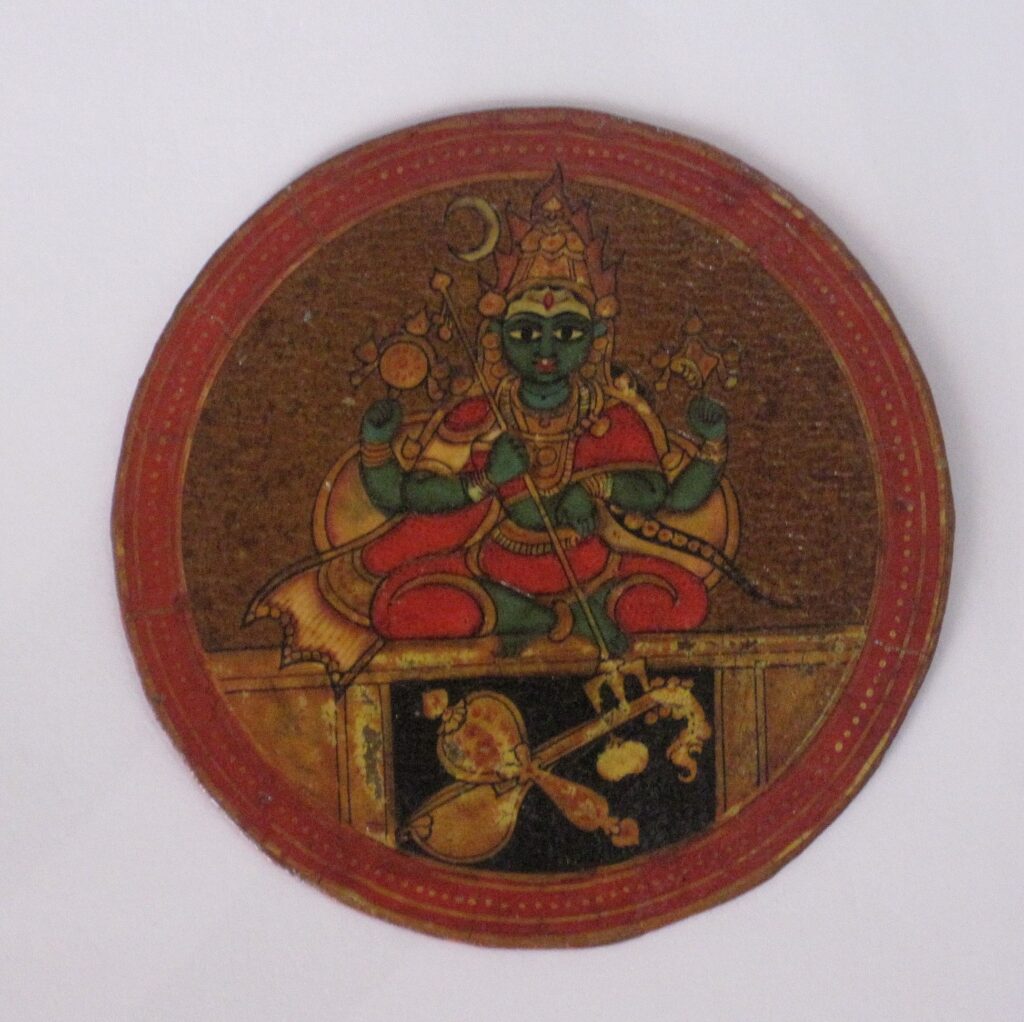
The Dashavatara Ganjifa which is a series with 10 different forms of the Hindu God Vishnu was the most popular Ganjifa game and is still known to this day. The Dashavatara Ganjifa has 120 different playing cards.
Historically, the paintings were done by hand and were circular in shape. However, rectangular ones have also been found. Other than the handmade papers that were recently discovered during the Mughal era, Ganjifa was traditionally cut from sandalwood or ivory and used colours of paint & silver/gold to create a design.
All Mysore Ganjifa paintings are painted with natural dyes, while the fine, delicate details are etched with squirrel hair brushes. The artists mix all colours by hand. All colours are derived from organic sources to produce an authentic paintings.
31 - Mysore Painting (Karnataka)
Mysore Painting is a form of classical South Indian painting that evolved in the Mysore city of Karnataka. It’s at its zenith under the patronage of Wodeyars, Mysore being under their reign.
The art of the Mysore school reached its peak during the rule of Raja Raja Wodeyar I. The occupation of artists dispersed after his death though, and the school ceased to exist.
Mysore paintings are often mistaken for Tanjore paintings, because the colors are very similar at first glance. However, closer inspection will reveal that Mysore paintings have finer brush work & more delicate colors, while Tanjore paintings have a rougher, more bold style with broader brush strokes.
In Mysore paintings, gesso is a low relief, intricate substance that is used in the background of a painting. This helps to bring out details such as clothes, jewelry and architectural features. Whereas in Tanjore school gesso has a lot of relief and is typically used for depictions or images that have deeper meanings or symbols behind them.
Mysore paintings are known for their gold leaf paint and often depict Hindu gods, goddesses or scenes from mythology. The natural beauty, intricacy and graceful quality of these paintings make them a favorite among many people.
The process of producing a Mysore painting typically follows a number of steps. The first step involves making a sketch on the basis, usually with the help of a preliminary sketch drawn with ink or charcoal or pasting cartridge paper on to a wooden base. Then paste is made of zinc oxide and Arabic gum, known as ‘gesso paste’.
Then, gold foil is pasted onto the surface. The rest of the painting is prepared with the help of watercolors. After the painting is fully dried, it is covered with a thin paper and rubbed lightly with a smooth soft stone.
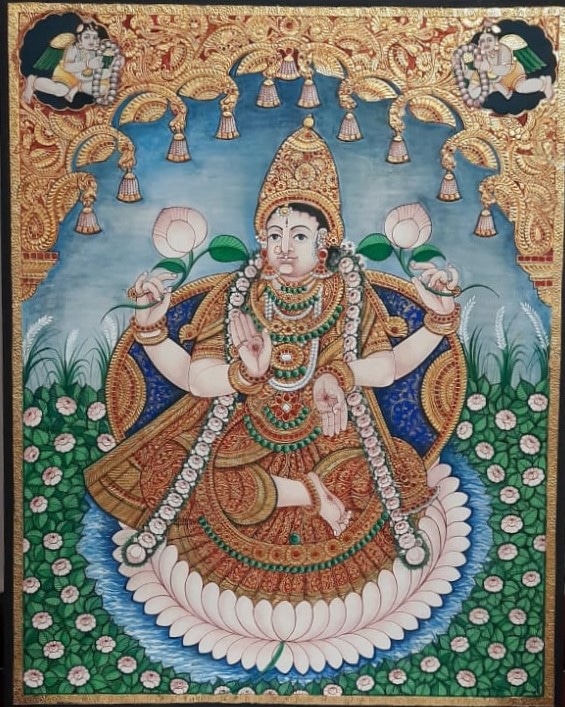
The sketches were made with the help of charcoal, which was prepared by burning tamarind twigs in an iron tube. The brushes were made of different materials, like squirrel hair, camel hair, goat hair, etc.
The work was taken up in the morning when the base of the gold work on the painting was still moist so as to hold the gold foil firmly. After allowing the painting to dry, glazing was carried out by covering the painting with thin paper and rubbing over it with a soft glazing stone known as kaslupada kallu. When the thin paper was removed the painting shone brightly and looked resplendent with the combination of gold and a variety of colours.
32 - Mughal Paintings
Mughal Painting, also known as Persian painting, was an art tradition in Persia (modern-day Iran), mostly during the Mughal Empire. It is often considered a part of the wider Persian miniature tradition, although the Indian influences are very strong.
Painters would paint scenes on miniatures which could either be single or multiple scenes. This form of art emerged from Persian miniature paintings and was used heavily by the Mughal Empire during the 16th century.
In Mughal painting, patronage from ruling emperors led to a its development as a court art. The art began to decline when the rulers lost interest. The subjects mainly come from a secular perspective, such as illustrations to historical texts and Persian & Indian literature, portraits of the emperor and his court, studies of natural life, and genre paintings.
The school had its beginnings during the reign of Emperor Humayun from 1530-40 and 1555-56. The emperor invited two Persian artists, Mir Sayyid Ali and Khwaja Abd al-Samad to join him in India. The earliest and most important undertaking of the school was a series of large miniatures of the Dāstān-e Amīr Ḥamzeh, undertaken during the reign of Akbar (1556–1605) which, when completed, numbered some 1,400 illustrations of an unusually large size. Of the 203 that have survived, the largest number are the Austrian Museum of Applied Art in Vienna.
The Mughal emperors were Muslim and they presided over the consolidation of Islam in South Asia, as well as pushing Persian culture and faith alongside arts. As a result, the Mughal Empire’s influence extended from Afghanistan to Bangladesh.
Mughal paintings started out as paintings from India, but other parts of the country discovered their style and adapted it. In some cases, this was for Muslim or Hindu subjects while others were adaptations for Sikh ones. In this way, regional styles developed when they were used. These are often described as “post-Mughal”, “sub-Mughal” or “provincial Mughal”.
Early in the Mughal era realistic portraits of people became a distinguishing feature of their style. Western printmakers who were in contact with the Mughal court influenced this style. The pose, rarely varied in portraits, was to have the head in strict profile, but the rest of the body half turned towards the viewer. This is a new feature that was not present in Indian (Hindu) painting.
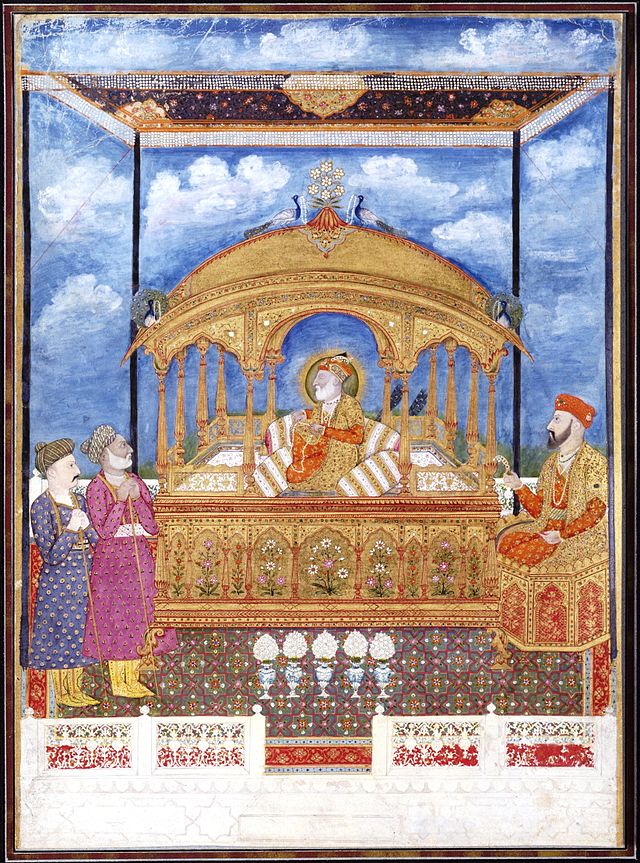
Akbar had an album containing only portraits of employees that he could quickly remember as he met with his advisors. One such illustration can be found in the Baburnama; some copies include sketches of those employees. With the reign of Jahangir’s son, Shah Jahan, Mughal portraits were at their best. They reached their greatest level of popularity during this period by inspiring the masters at the court studio.
33 - Nirmal Painting (Telangana)
Nirmal Paintings are a popular form of Indian folk art done in Nirmal in Nirmal District, Telangana, India. The paintings in this gallery are made using only natural colors and the main themes are religious, rural scenes, family scenes and landscapes.
Telangana -town of Nirmal is known for its crafts and art. The locals, called Naqash, make beautiful handicrafts which are sought worldwide. The paintings on Nirmal products capture the rustic ethos to the royal environment and show beautiful forms in a variety of colours. There are explicit images that capture flora and fauna.
Once upon a time, the Nizam of Hyderabad was welcomed with a grand ceremony in Nirmal. The artisans decorated the venue and built a throne for the Nizam with an intricately designed banana bud, which they believed would not only look good but also hold his weight.
He was bathed in a golden cascade of petals. This led to the Nizam patronizing the artisans, impressed by their skill. In 1951, Lady Hyder brought a group of artisans to Hyderabad and promoted this craft. This was under the Cottage Industries division in the Nizam’s government.
Most of the paintings in Nirmal rely on traditional scenes from the ancient Hindu epics, Ramayana and Mahabharata. They’ve been influenced by other styles, like Kangra, Ajanta and Mughal miniatures. The art form has been around for a long time and is still popular among customers to this day.
Many colors are found in Nirmal paintings, and most of them come from natural sources. The motifs are also pretty popular, with nice finish on the canvass. Birds are always depicted very nicely, and the world-class export quality is what you can expect from these paintings.

Nirmal painting technique involves applying lacquer on a wood surface and then painting the desired design. The paints used in Nirmal paintings are made from natural colors which come from extracts of flowers, plants, minerals etc.
The paintings depict scenes ranging from the grace of a dancer or a musician’s rhythm to birds, panoramic nature settings, and they fully captivate the attention of the viewer.
Earlier, the wood of Tella Poniki tree was used as a painting board after being processed manually. In recent years, artisans have been using Indian Teak because of its grain texture and weight.
Once the painting has been completed, clear spray is used on the frame for water resistance. The Nirmal painting of Mughal miniatures is highly attractive. As it “ages” it acquires a special muted glow and this is considered impeccable.
34 - Pattachitra Painting (Odisha and Bengal)
One of the most famous forms of Indian folk art is the Pattachitra. It consists primarily in paintings on cloth and depicts mostly Hindu divinities. “Patta” means “cloth” and “Chitra” means “painting”
Pattachitra painting is a traditional Indian folk art of Odisha that’s been around for centuries. It was originally used for rituals and as mementos to pilgrims. Today, it can be seen on everything from walls to boxes of sweets. You can find a Pattachitra on almost any surface in Odisha, but some of the most interesting pieces are on the pillars outside.
Pattachitra, which is an ancient form of Indian folk art, serves as a visual tool during the performance of Bengali songs.
The paintings of Odisha can be divided into three broad categories from the point of view of medium, i.e. paintings on cloth or ‘Patta Chitra’, paintings on walls or ‘Bhitti Chitra’ and palm leaf engravings or “Tala Patra Chitra’ or “Pothi, Chitra’. The style of all these remains more or less the same at a specific time because the then artists were commissioned to work in all these media, it is believed.
The paintings seen in Pattachitra drawing resemble old Odisha’s paintings of famous temples and centres of Puri, Konark and Bhubaneshwar region, dating back to the 5th century BC. The best work is found in and around Puri, especially in the village of Raghurajpur.
Pattachitra painting is done with 4 colors, red, yellow, white & black.

Bengal Pattachitra is a traditional genre of painting from West Bengal. It’s also known as the Maha Patachitra and is dated back to ancient times. It includes different styles, for example Durga Pat, Chalchitra, Tribal Patachitra and Medinipur Pattachitra.
The subject matter of Bengal Patachitra is mostly religion, myths, folk stories and social. The Kalighat Patachitra, the last tradition of Bengal Patachitra is developed by Jamini Roy. The artist of the Bengal Patachitra is called Patua
35 - Patua Painting (West Bengal)
Patua is an India folk painting that originated in West Bengal. This type of art is traditionally drawn on a piece of cloth known as a pati (or patta).
The paintings are stitched onto the scroll, which is strengthened by adding fabric from old saris to the back. Sometimes, one scroll can have a scene or panel from a longer story painted on it. It could also have images of animals or scenes that were made up by the artist.
Patuas, like other traditional painters, began by painting scrolls or patua depicting the mangal stories of the gods and goddesses.
For generations, scroll painters or patuas have gone from village to village telling the mangal stories of the gods and goddesses. People found these scrolls to be a great source of entertainment.
Traditionally, Patua painters used a brush made of bamboo and goat hair. Today, scrolls also depict current affairs, history, and other subjects apart from the traditional themes. Painters use vegetable dyes with vegetable gum fixed on paper.
The Patua are an artisan community found in the Indian states of West Bengal, Bihar, Jharkhand, and Odisha, as well as parts of Bangladesh. Some Patuas are Hindu, while others are Muslim.
Hindu Patuas are active in the Kalighat and Kumartuli regions of Calcutta, as well as other parts of West Bengal. Their population is small.
Although the origin of the Chitrakars is not clear, historical and mythological memories coincide that it is traceable back to the 13th century. The Patua are a unique community who paint and model idols. Chitrakar is a widely-used term for a Patua artist or sculptor. They originated from Patua which means an artist, sculptor or painter.
There are a number of theories about the origin of this community, one of which is that they were cast out when they fell out with their Brahmin priests.
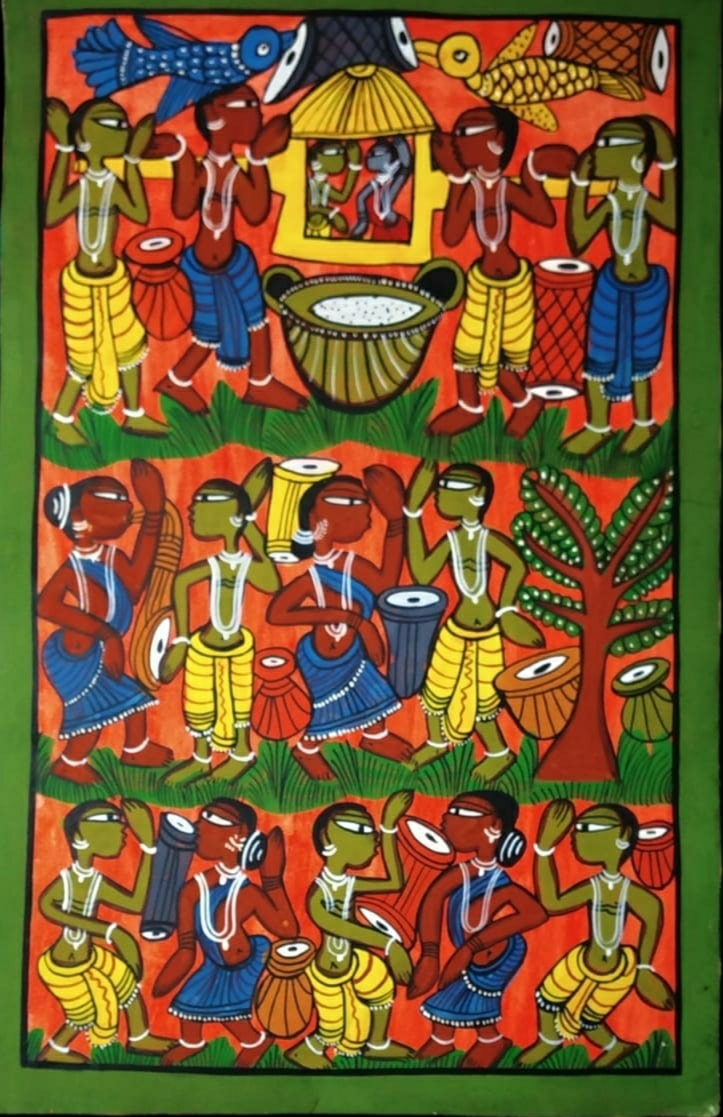
36 - Pipli Art (Odisha)
Pipli Art, Odisha: The city of Pipili, in Puri District, Odisha, India is known for its appliqué work–also known as chandua or odia cānduā. The word “appliqué” comes from the French language meaning to put on something.
There are two different techniques, appliqué and reverse appliqué, that can be used to construct a multilayered textile. In appliqué, a luxurious fabric is sewn over the base layer. In reverse appliqué, two layers of fabric are laid down and then cut out in sections.
Pipili appliqué work originates from the 12th century, during the time of Lord Jagannath. Earlier, Gajapatis prepared these as canopies and umbrellas for Ratha Jatra during the day.
In the 13th century Puri kings employed craftsmen to make offerings to Lord Jagannath. They set up a village for these people named Pipli. There is a history of people in Assam making clothes for the chariots of Lord Jaganath, Balabhadra and Devi Subhadra.
With royal patronage, the appliqué work became the pinnacle of quality. According to temple records, Maharaja Birakshore of Puri appointed the darji or tailor community to supply appliqué works for the daily rites performed in his temple. This is one way they make money for themselves. However, the sale of handicrafts is also an important source of income to them.
Sewing is a craft that involves embroidering and stitching. The pieces of cloth are fastened with the help of straight stitch, satin stitch, blind stitch or buttonhole stitch. There are also special stitches like “mirror work” and decorative stitches.
Appliqué works are mainly used for dressing up gods during their various journeys. You can see items like an umbrella, a Tarrasa, a heart-shaped wooden piece covered by appliqué cloth and supported by a long wooden pole and Chandua – an umbrella shaped canopy – during the processions.

One of the most popular trimming items is a frill, which can be used at the border of a canopy or on its own for decoration. The peacocks, ducks, parrots, trees, elephants or creepers in these paintings may be a little more believable than the mythical creature Rahu.
In modern applique work, stylized representations of flora and fauna as well as a few mythical figures are frequently used. More common animal motifs are elephants, parrots, peacocks, waterfowl, creepers. Plants are also common motifs including lotuses, jasmines and the sun.
37 - Pichwai Painting (Rajasthan)
Pichwai paintings also known as “Pichvai” is a traditional Indian Indian folk art having its origins in Rajasthan, India. It consists of a series of painting on cloth using natural colors and vegetable dyes. The paintings are done with a natural brush made from animal hair or cotton threads.
Pichwai (pichvai) is a style of Indian folk art that originated over 400 years ago in the town of Nathdwara near Udaipur, Rajasthan, India. Intricate & visually stunning, pichwai paintings are made on cloth and typically depict tales from Lord Krishna’s life.
Pichwai arts are paintings of Lord Shrinath which are usually carried out on fabric in dark, rich colours. These Indian folk arts have an ancient religious significance and are done by hand with great devotion by the artist.
Most texts under this style revolve around Shrinathji, who is seen as a manifestation of Krishna, and the text will mention how he held the Govardhan hill on his last finger. Pichvai paintings mostly depict scenes from Shrinathji’ s life and various scenes of his celebrations.
The Pichwai paintings are a tradition that is practiced by the Hindu Brahmins of India. This religious tradition is believed to have roots in the Vedic period and is executed with utmost devotion by the artists. The paintings can be seen as a map to the universe and are used as a way to see how all of these pieces fit together.
Subjects of Pichwai paintings are mostly depiction of Lord Krishna’s various moods or various sevas (offering) of Shrinathji.
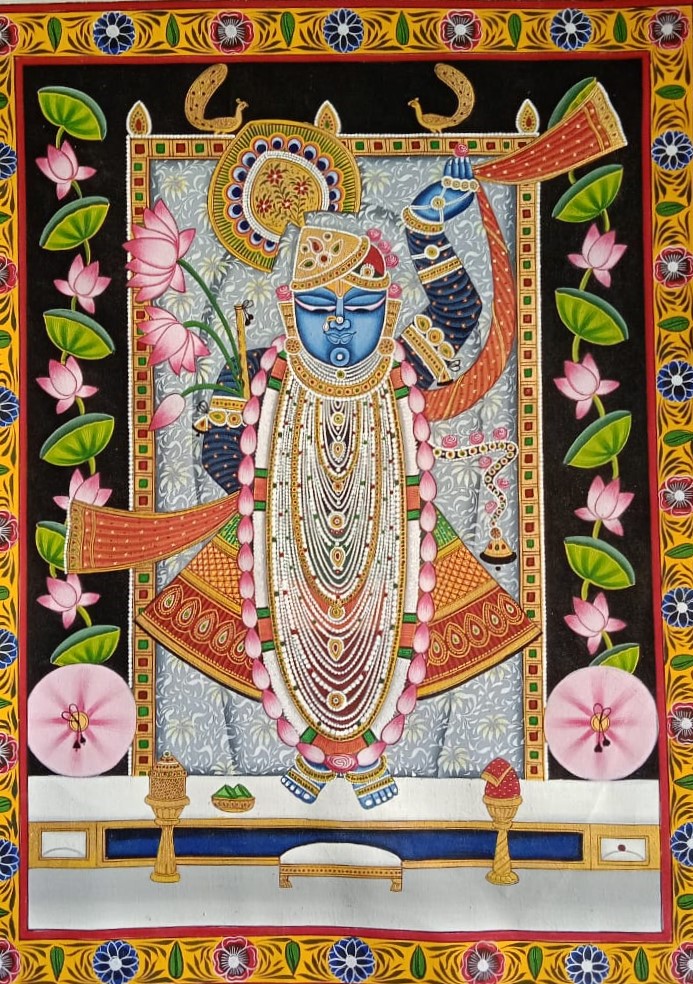
Careful detailing is required to paint a Pichwai. Lord Krishna is sometimes depicted as Shrinathji in these types of paintings, which are of the deity manifesting as a seven-year old child.
Other common subjects in Pichwais are Radha, gopis, cows, and lotuses. Festivals and celebrations such as Sharad Purnima, Raas Leela, Annakoot, Govardhan Puja, Janmashtami, Gopashtami, Nand Mahotsav, Diwali, and Holi are beautifully presented for centuries.
38 - Pithora Painting (Madhya Pradesh)
Pithora painting is a widely famous style of traditional Indian folk art from Madhya Pradesh, where figures are painted on the wall.
Pithora Painting is an indigenous form of art practiced by the Bhil and Bhilala tribes in Gujarat and Panchal Plateau. To paint a mural, artists only use white water-based paints and no other decoration.
Pithora paintings are known for their scenes of harvesting, fertility of land, festivals, childbirth etc.
Paintings are often considered sacred in Pithora culture and Baba Pithora is the god who’s worshipped to heal illness and undo bad omens. A painting has to be created following consultation with a tantric after worshipping, and this has to be done at the main wall of the house.
Likhandra was invited to create paintings using khakhra (Butea Monosperma) brush stems. khakhra (Butea Monosperma) is a species of Butea native to tropical and sub-tropical parts of the Indian Subcontinent and Southeast Asia.
Khakhra (Butea Monosperma) is also used for timber, resin, fodder, medicine, and dye. The wood is dirty white and soft. Being durable under water, it is used for well-curbs and water scoops. Spoons and ladles made of this tree are used in various Hindu rituals to pour ghee into the fire.
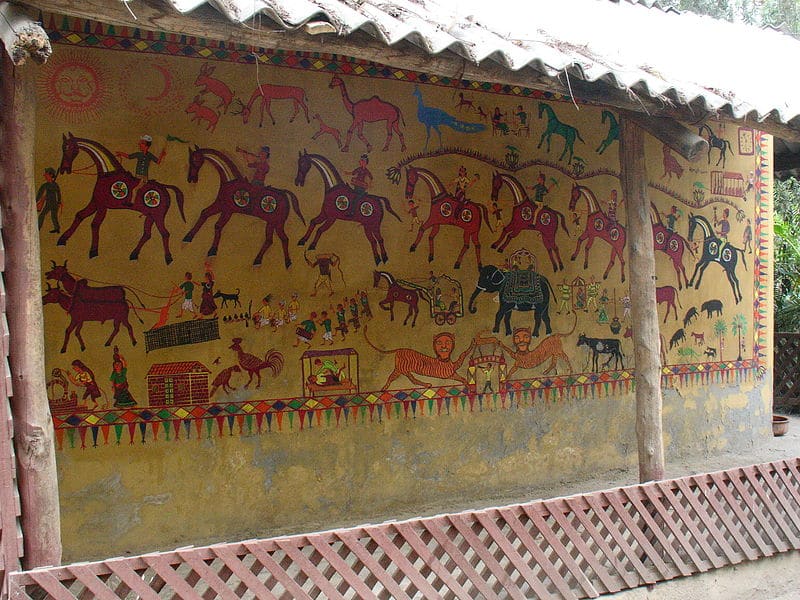
Colours are made naturally in a variety of ways. White is made from lime, green from sanguan leaf extract, black from lampblack, red from sindoor and vermillion.
One of Pithora paintings’ common motifs are the Kathiyahoda or Black Horse with rider. This is followed by four White Horses facing each other, two headed Mares of gods of rain clouds animals, bowri(the step well), women churning butter trees etc
39 - Rajasthani Miniature Painting (Rajasthan)
Rajasthan is one of the pioneers of miniature paintings in India. This Indian folk art form evolved here in Marwar-Mewar region as textual illustrations to the Jain text Kalpa-Sutras around the early 15th century. In these paintings there’s a strong connection to the great art of Ajanta and Gujrat.
This first Indian folk art style began to take form in the Bhagava paintings of Palam (carried out around 1555) and has been widely used in the art styles of Rajasthan. This style incorporates indigenous art forms as well as Western influences.
Rajasthani school of painting was first seen during the end of the 16th century for Mewar. Many various painting styles developed in Rajasthan over time, though the most famous ones are Kota, Bundi, Bikaner, Kishangarh and Mewar. At present-day Jaipur.
Rajasthani Miniature art was influenced by the Mughal style but it had its own personality and perspective. This part of the difference came from Rajasthani artists’ more lyrical approach, as well as their pleasure from pure lines and colors. The other part of the difference lay in the preoccupation with capturing a sense of sacredness.
They mainly used primary colors (such as red, blue, and yellow) along with green, brown, and white. Gold and silver were also used in some paintings.
Two main factors contributed to the development of Rajasthani paintings: first, the patronage of rich Rajputana communities and second, the revival of Vaishnavism and the growth of bhakti cults.
There were a variety of themes in Rajasthani Paintings, including seasons (Bhahmasa), Ragamala (Rag-Raginis) music, hunting, religious themes from the Ramayana, the Mahabharata, and love scenes of Radha and Krishna.
The bulk of miniature paintings that depicts the initial art style of Rajasthan in its most undiluted form, is reported from Mewar. Bold lines, emotionally charged faces, sharp features, robust figures and basic bright colours are its distinctive features.
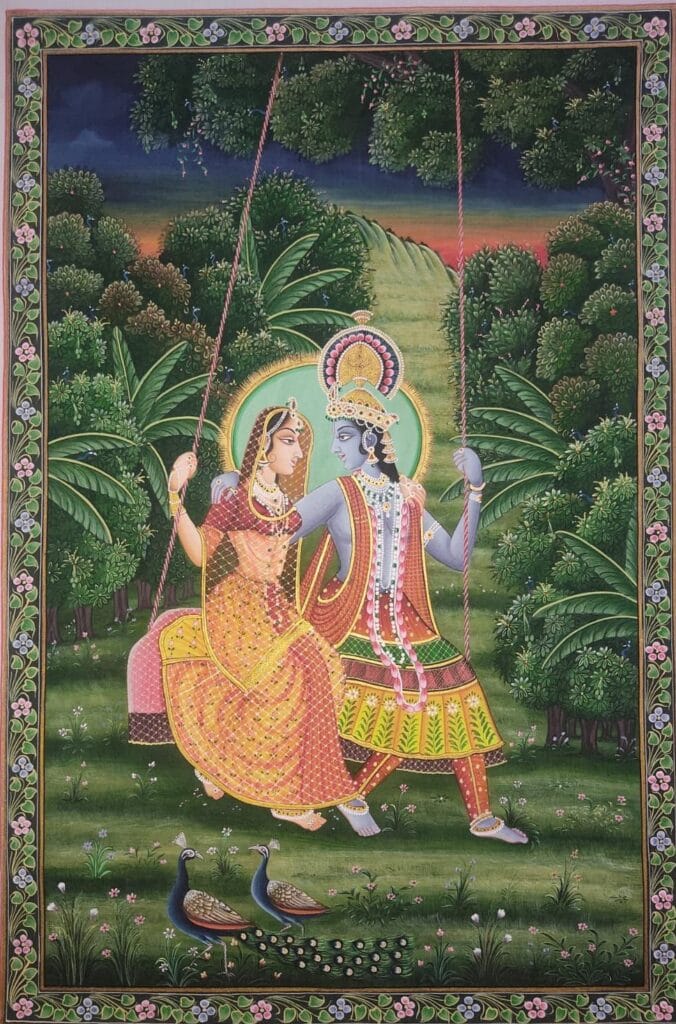
There developed at Shahpura, Pratapgarh, Deogarh and Nathdwara sub-centres of Mewar art. Shahpura and Pratapgarh excelled in royal portraits, Deogarh in variety of themes and Nathdwara in representations of Shrinathji. Nathdwara used a variety of mediums but it surpassed all in its large size cloth wall-hangings, known as ‘Pichhawais’.
40 - Rajasthani Phad Painting (Rajasthan)
The Indian folk art, Phad Paintings date back to a 700-year-old legacy and they get their name because of the way they were traditionally rolled or folded. These are created using the scroll technique. The paintings depict local tales by scrolling up & down, representing both sides of the story. They were carried around by priests who would sing out the stories to set them in motion
Phad painting is an Indian folk art style of religious scroll painting. It’s mainly practiced in Rajasthan and usually done on a long piece of cloth or canvas, which is called phad.
The stories of the gods from Rajasthan – mostly Pabuji and Devnarayan – are shown on these ‘phads.
The Bhopas, folk singers traditionally carry the painted phads along with them and use these as mobile temples for worship; they’re used by the Rebari community of the region.
The Phads (flags) of Pabuji and Devnarayan are normally about 15 and 30 feet respectively. Traditionally the flags were painted with vegetable colors.
Previously, Phad painting was practiced exclusively by the Joshi community. It is understood the Phad paintings made in Jaipur lacked the vibrancy and aesthetics that was present in the paintings made by Joshi families of Bhilwara and Shah Pura. Abhishek Joshi, 13th generation Shah Pura Joshi family artist now teaches Phad painting through his online E-learning courses, also runs many workshops.
In 1960, Shree Lal Joshi opened a school called the Joshi Kala Kendra to teach students from various castes how to paint this art style. The name of the school eventually became Chitrashala.
The Devnarayan Ki Phad and Pabuji Ki Phad are traditional forms of this art. They were revolutionized by Shree Lal Joshi and Pradip Mukherjee in the 1980s. Mukherjee’s paintings are based on the stories of Ramcharitmanas, Gita Govinda, and Kumārasambhava
Shree Lal Joshi introduced and composed new themes for this traditional Indian folk art form, based on the episodes of the Devnarayan Mahagatha, the battle of Haldighati and the jauhar (self-immolation) of Padmini (continued)
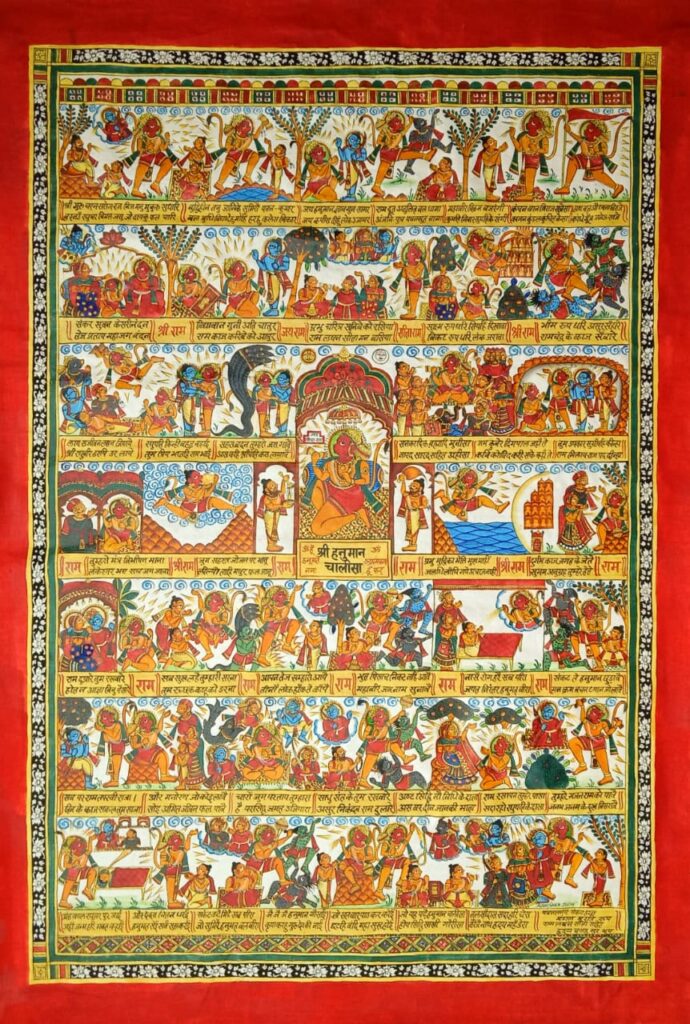
the lives of Maharana Pratap, Prithvi Raj Chouhan, Rani Hadi, Padmini, Dhola Maru, Amar Singh Rathore, Buddha, Mahavira and the narratives from the Gitagovindam, the Ramayana, the Mahabharata and the Kumarasambhava.
P. Mukherjee created 108 miniature paintings of the Ramcharitmanas, each measuring 11″ x 8″. Each one had 6 to 8 panels, with different scenes portrayed. This was the first time these elements had been included in Indian painting.
41 - Rogan Art from Kutch (Gujarat)
Rogan painting is a traditional Indian folk art with textile printing technique, whereby fabric is printed with oils and vegetable dyes and marked by either blocks (printing) or a stylus (painting). Rogan Art is a 400 years old traditional painting technique that nearly died out before being revived by two families in the same village.
The word Rogan comes from Persian, meaning varnish or oil, a term adopted under the Mughal Empire. A tool of many uses, this oil based paint is typically applied to fabric to produce a beautiful and durable finish. It is traditionally used by the Muslim community in Kutch – a province of India. The name ‘Rogan’ and some traditional designs may suggest an origin from Iran but there are no historic records available to confirm this.
Rogan painting was created in the Kutch region 400 ages ago. The painted fabric was mostly purchased by women of the lower castes who wanted to decorate clothing and bed coverings for their wedding. Therefore, it was a seasonal art, with most of the work taking place during the several months when most weddings take place. In the ‘off season’, you would have artisans doing other kinds of work, such as farming.
In the late 20th century, cheaper machine-made textiles made Rogan painting an occupation that is more expensive. The Khatris of Nirona, Gujarat are the only family to continue the craft.
Rogan paint is produced by boiling castor oil for about two days, then mixing in vegetable pigments and a binding agent. The resulting paint is thick & shiny. The color of the material that is typically painted or printed on is usually dark, which helps the bright shades to stand out and be easily visible.
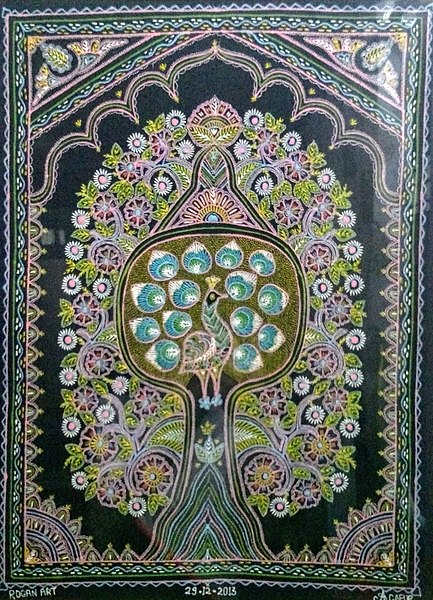
In Rogan painting, elaborate designs are produced freehand, by trailing thread-like strands of paint off of a stylus. Frequently, half of a design is painted, then the cloth is folded in half, transferring a mirror image to the other half of the fabric. The designs include floral motifs, animals, and local folk art
42 - Reverse glass Tanjore Painting (Tamil Nadu)
Reverse glass painting is a centuries-old folk art form that was created in Italy and then spread across Europe in the 16th century. Reverse glass painting was first introduced to China’s market by western Catholic missionaries in 16th and 17th century.
It quickly became popular among the nouveau riche who wanted to maintain an outward appearance of wealth & success, but on a budget. By 18th century, the Reverse glass painting craze had spread to India’s west coast where many Indians are willing to spend.
The adoption of colour glass art was associated with symbolic and cultural figures and occurrences as early as 5th century.
There are three types of glass paintings
-
Stained glass work is a type of art in which colourful glass is used to make decorative windows and other objects which let light pass through. It can be lovely for people to look at. Europeans used to stain the already cut and shaped glasses in metallic salts. They would then trace the drawing and paint the composition on the stained glass. To form a complete piece of artwork, first the paint is applied on the glass and then it’s fired in a kiln to permanently fuse with the surface. Lead strips are used as an adhesion to completely top off what you’ve created.
-
Reverse glass painting is an art form that is painted from the reverse side of the glass. The paints for these paintings are made by grinding and mixing the pigments with binders such as gum or resin. Then the paint is applied to the front of the glass in reverse order and the unpainted areas are coated with mercury, providing a mirror background to the colored images.
-
While the origins of the term are opaque, reverse glass painting appears to be a form of art that was done by painting on the other side of a glass sheet. It’s usually done with oil paints, but water colours with gum have also been used.
With the expansion of the British Empire, Indian artists learned the technique and began producing reverse glass paintings for wealthy Indian aristocrats who sought to mimic the colonial officers.
In the late 18th-century and early 19th-century, there was a high demand for religious paintings that featured gems, pearls and cut glass in southern India. Reverse glass paintings came as a less expensive Indian folk art alternative and reached a far wider audience.
The use of reverse glass paintings spread across Western and Southern India, reaching to former provincial Mughal capitals in Awadh and Murshidabad, Rajasthan and Central India. To some extent.
Reverse glass painting depicts Indian legends from Hindu mythology and reflects a rich tradition. Meanwhile, secular themes such as portraits of kings, nobles, courtesans & musicians are also depicted.
The paintings have a distinct style of bold colors, rich subject matter and have a certain flavor of Indian mixed with Western motifs. A special feature of reverse glass painting in India is the mixture of various East & West elements.
Reverse glass Tanjore paintings typically reflected the mixture of Indian and Western elements, sometimes introducing trees in the background and figures in the foreground with intricate details of costumes and jewelry.
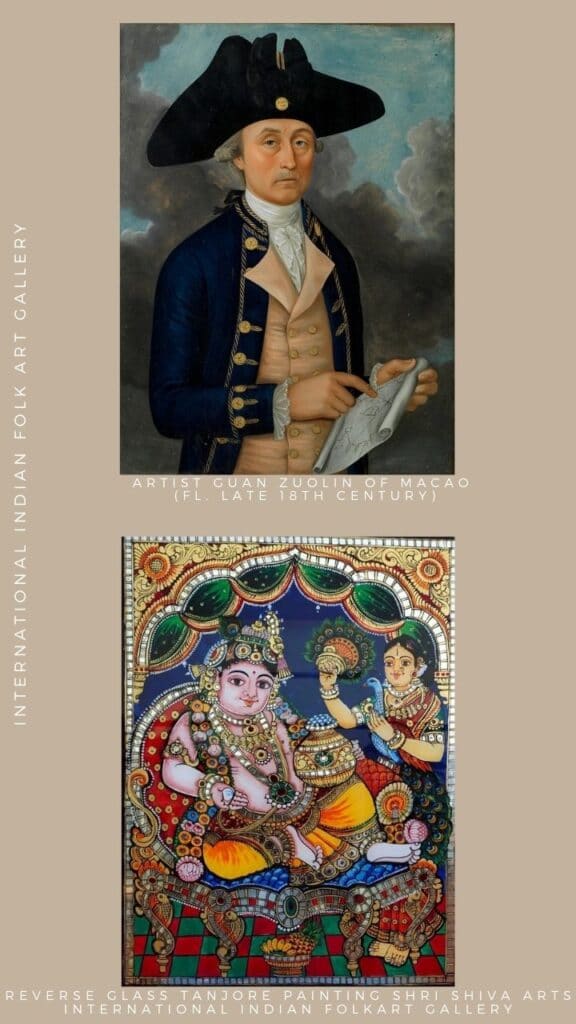
The process of making reverse glass paintings is absolutely amazing and need special skills. This is a laborious technique that requires a good memory of the whole composition because the drawing that has to be made on the glass is drawn in such a way that it is the mirror image of the real composition and the application of the paints is done from the back in a reverse order.
The first step for reverse glass Tanjore painting is to place a piece of clear glass under your drawing. On this, you’ll trace the finer lines on the glass to transfer it later. Any decorations like gold effect or stones must also be added to this stage.
For larger areas of opaque colors, usually either oil or tempura paints are applied and shading is used to achieve a sense of depth. Unlike stained glass paintings, the reverse glass paintings do not use any binding media or firing.
In reverse glass Tanjore painting, the glass sheet is both the support on reverse as well as the protection from the front now.
The traditional reverse glass Tanjore painting is dying because the artists who do it are getting older and lack the knowledge and skills to carry on this particular craft.
43 - Saura Painting (Odisha)
Eastern India has some beautiful roots in folk art, represented through the Saura tribe’s wall painting tradition. Particularly evident in regions like Orissa. The Saura people’s paintings are also called ikons. These pictures were traditionally painted on their houses, but now they are well known all over India..
Saura art is a really interesting way to see how the Sauras lived and what they believe. They’re a tribe from the state of Orissa, but they’re really dynamic and colourful. With a history that has been mentioned in the Ramayana and the Mahabharata, the Sauras are known for their distinct tribal culture and their art.
Another interesting facet of the Kerinci people is their deep connection to nature. Their family art reflects this and seems to be a simplistic depiction of village life. The Saura people rely on their art and the symbolism within it to hold on to their customs and culture.
For the Saura tribe, who do not have a written language, their artwork is often used as a record of history, philosophy and other cultural beliefs.
Saura art is traditionally made on the red or brown clay walls of the homes of the villagers, with natural dyes made from rice, white stone, and flower and leaf extracts, using a brush that is made from tender bamboo.
The paintings are usually of Idital, the deity of the Sauras tribe who helps people during auspicious occasions like harvesting or child-birth.
Saura’s icons tap into a variety of recurring symbols, some of which include people, the tree of life, the sun & moon, horses & elephants. In traditional cultures it was only priests who could make icons. They would also tell their village folk about their culture and customs using an oral tradition.
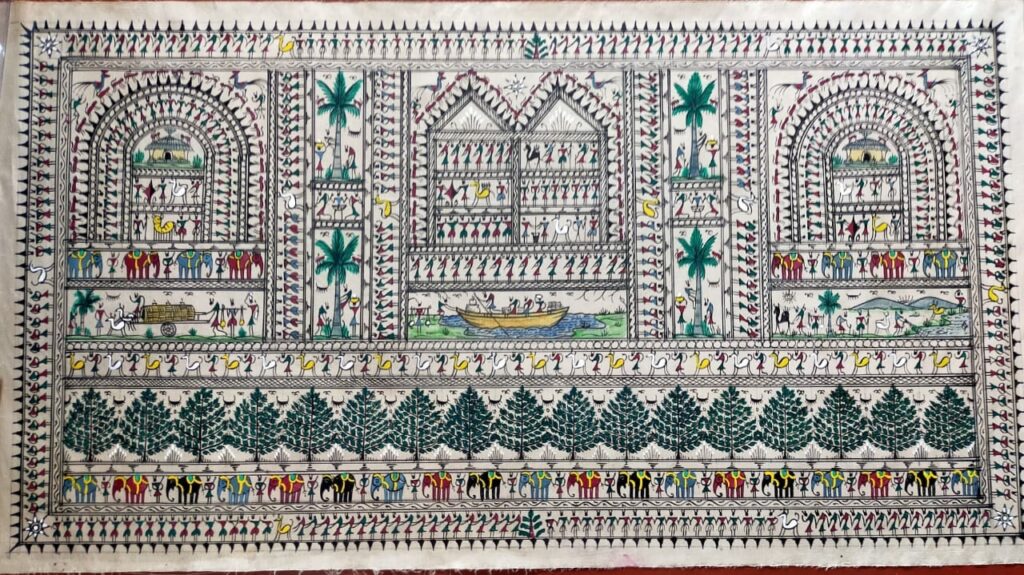
As seen at a glance, Saura seems to be the identical twin of another tribal artform from India that is also better known. Made up of similar geometric shapes, in earthy colours, these two artforms are often hard to differentiate. There are subtle differences between the two however – ranging from the composition of the forms to the pattern they’re placed in.
The figures in the Saura style are less angular than the Warli style. In Warli art the human body is depicted by two sharp triangles conjoined at the apex.
The Saura forms are also larger and more elongated than the ones seen in Warli art, with no physical differentiations between male and female shapes.
Another distinct characteristic of Saura art is the ‘fishnet’ approach with which all the artworks are made. When drawing a Saura artwork, the border is drawn first and then patterns fill in the space towards the center.
44 - Sanjhi Art (Uttar Pradesh)
The Indian folk art, Sanjhi has been around since ancient times and required a lot of patience, skill and precision. It was traditionally used to create intricate Krishna-themed Rangoli patterns at temples.
Based on mythology, Radha, Krishna’s beloved lady-love used to hang on to her freshly plastered cow dung walls by using colored stones, metal foils and flowers, to draw Krishna’s attention.
Seeing Radha do this, other Gopi’s in Vrindavan began painting walls with Sanjhi art to attract Krishna. ‘Sanjhi’ is derived from words like “Sajja”, “Shringar” and “Sajavat” which all mean decoration.
Sanjhi is linked with the Indian ritual of unveiling the Rangoli at dusk. It is often chanted near the temples. Sanjhi is a traditional Indian art form with many intricate designs and delicate patterns. Designs are often based on legendary Hindu tales of gods.
Designers will often cut a stencil out in a shape of what they want to create and use it in a repetitive fashion in order to create their wanted image. They do this with the help of small custom scissors.
The Rangolis were made using colours, flowers or stones. Some craftsmen also practiced Sanjhi during the Mughal era, but in entirely different themes.
Earlier, artisans would use rough paper or banana leaves to make stencils, but in contemporary times handmade and recycled papers are also used.
Traditionally, the stencil was the only type of Rangoli, but gradually stencils caught the interest of patrons. Now, stencils are considered equally as beautiful as the final decoration. Cutouts are available as framed artworks as well.
This folk art painting depicts the culture of the region. It was made better by Vaishnava temples in the 15th and 16th century. Sanjhi evolved to become a high level of art done by Brahmin priests
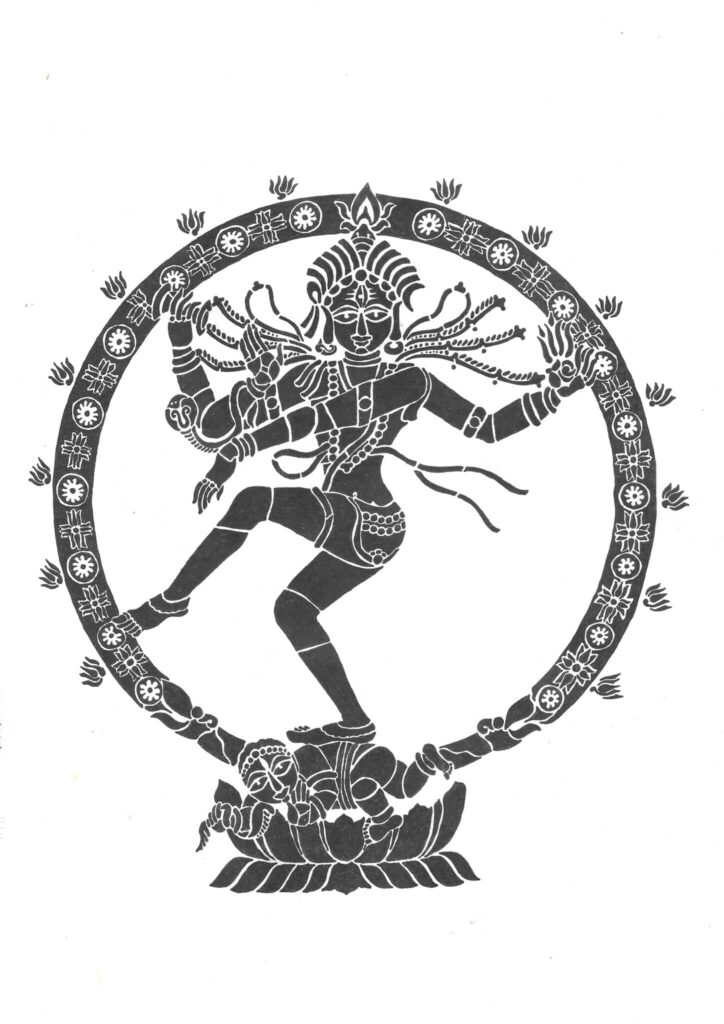
The Indian folk art, Sanjhi has been around since ancient times and required a lot of patience, skill and precision. It was traditionally used to create intricate Krishna-themed Rangoli patterns at temples. Sanjhi Art tradition originates from the state of Uttar Pradesh’s Vraja district, which is where Krishna was born.
Presently, the ancient art of paper decoration is only practiced by a handful of individuals. It remains an important tradition at many temples including the Radharamana temple in Vrindavan.
45 - Sohrai Art (Jharkhand)
In the city of Hazaribagh in Jharkhand, India, an indigenous Indian folk art form called Sohrai Art is practiced by the women. It’s a ritualistic art done on mud walls to welcome the harvest and to celebrate cattle.
The Sohrai art form is popular in 10,000-4,000 BC and decorating walls with murals of this kind was common in caves. In the last few centuries, the paintings have been hung on mud walls.
The name, Sohrai comes from the Mundari word Soroi which means to lash with a stick. Usually, people use sticks on animals and livestock!
They created the paintings on two occasions: one time after it had rained and before the harvest. The other was during weddings.
They make a layer of mud on the wall, and while it is still wet they use their fingertips to create various designs. These generally include fruits and flowers as well as other illustrations of nature.
The dark outline on the walls is visible because of the white mud that was applied on top and it’s not a part of the design. This is how artists from Sohrai show their spontaneity in terms of drawing different patterns on the wall, without much planning.
Some artists focus on designing their canvases to be between 12-18ft wide. These designs are almost always based off the artist’s memory and personal experience. The artwork reflects an interest in nature and human interactions with it.
The colour palette of Sohrai paintings is just as intriguing as its history: natural earth ochres that can be found in abundance in the vicinity. The brushes they use to paint with are twigs from the Sal tree.
Rags made of cotton fibers are used to make the background. You can color them using the following colors: Red ochre, Yellow ochre, Manganese or powdered coal or Kali Mitti, and White clay or Dudhi/charak mitti.
While both red and yellow ochres are available locally or can be foraged in the hills, red ochre is usually found in the form of hematite near Hill Rivers.
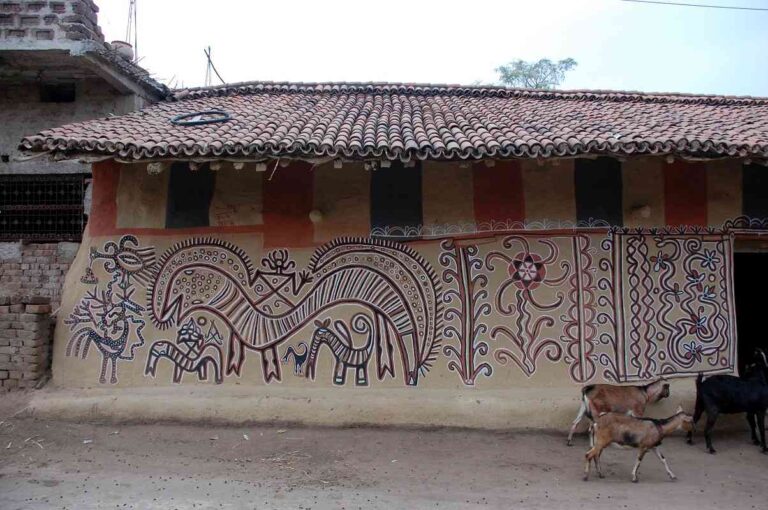
Around mines, black earth is often found due to the heavy presence of manganese. However, if this is not available, coal is powdered for the purpose. White clay can be extracted from limestone mines and this process can also be quite hazardous.
Sohrai Day takes place one day after Diwali and a few days after Govardhan Puja, which is a cattle-related festival.
Houses that are decorated for the festival only last until the end. For some tribes this decoration is just decorative. However, it signifies an act of deep respect which is integral to their culture.
46 - Surpur Folk Art (Mysore)
The Surpur style of Indian folk art that is considered as an offshoot of the Vijayanagara style. The art flourished under the patronage of rulers for about two centuries, particularly during the reign of Immadi Venkatapa Nayaka and Mummadi Venkatapa Nayaka.
The present day Surpur style paintings owe their origin to the murals found in the walls of ruined mansions and temples of Surpur taluk in Yadgir district.
The style is similar to the more established Mysore (now Mysuru) and Tanjore styles of painting in terms of the gesso work and the rendering of gold leaf with embedded semi-precious stones.
Surpur miniature art, recognized as one of the finest miniature art forms in the world, is facing extinction due to lack of institutional support and training to budding artists by seniors to keep this beautiful art form alive. The thematic content adheres to mythology and Vedic themes such as the ashtadikpalas or the guardians of eight directions.
While some paintings were made in honor of kings and noblemen, some paintings were used to embellish actual photographs.
Colonel Philip Meadows Taylor, an able administrator and an artist, contributed significantly to preserving these paintings when he served in Surpur as a representative of the Nizam of Hyderabad. He worked in the region from 1842 to 1850. He took many of these works when he returned to England and they are found in the museums of England even now.
Surpur miniature Indian folk art flourished under the then Surpur ruler Raja Venkatappa Naik during 1773 to 1858, which was described as the golden age of Surpur. It was during this period that artists from the Garudadri family, practicing miniature painting, migrated from Andhra Pradesh to Surpur (now in Yadgir district).
Banaiah Garudadri was the artist who popularized this art form and trained a number of artists who mastered in this art form in the erstwhile Surpur kingdom.
Intricate strokes in imaginative colors and use of pure gold thread embedded in the paintings, depicting tales from Indian mythology, provided grandeur to the paintings.
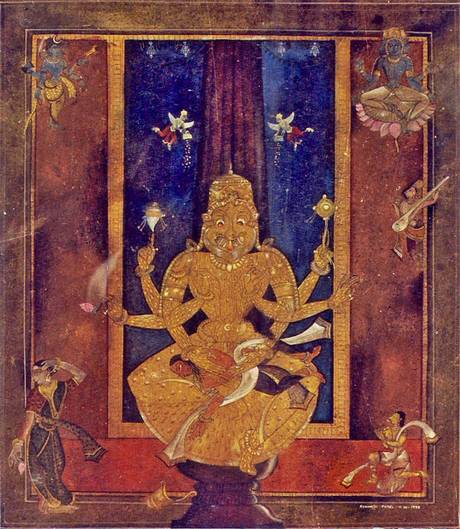
It is understood that although the government released enough funds to the academy to support various art forms and help the artists, so far, the academy had not earmarked even 10 per cent of the funds for the protection and support of the traditional art forms, while major funds were spent for uplifting western art forms every year.
This style of Indian folk art was neglected for long, for almost a century. Since each Indian folk art form has a unique creation process, in the absence of teachers artists must try to replicate the existing work of art using modern methods and techniques. Such an effort was made by artist Vijay Hagargundgi who is credited with reviving the art and fitting it into the modern medium.
47 - Tikuli Art (Bihar)
Tikuli art is a unique type of Indian folk art from Bihar with a rich history. Literally, the word “Tikuli” means “bindi” which is what they wear on their forehead usually as decoration.
The Bindi, traditionally an Indian headpiece worn by women, was originally created to symbolize worship of intellect. They are still used for religious ceremony but have become more mainstream in recent times. The Tikuli art style has enabled women artists to be creative and express themselves whilst challenging the male-dominated industry.
Tikuli art originated 800 years ago in Patna. It deals with beautifully designed paintings which are manufactured in the local streets of the city. With its popularity, Tikuli art managed to attract more traders to buy it in bulk. This had catapulted the Mughals to take an interest in it, who appreciated the finer points of this art-form.
As the Mughal Empire began to decline and the British Raj took over, indigenous arts like Tikuli faced a sharp decline. Industrialization had caused people to abandon the local trade for machine-made options that weren’t as high quality. Thousands of Tikuli artists were left jobless when machine-made bindi entered the market, causing Tikuli art to cease production.
The revival of this art form solely took place due to a few key influencers. In 1954, Chitracharya Padmashree Upendra Maharathi became aware of this dying art and decided to take action in preserving it.
Tikuli is a very special art form of Bihar. Unlike other forms of embroidery, it requires extremely detailed skills. This is because there are many fine details in the work that needs to be taken care of (An interesting fact about Tikuli is that the more tedious the work with even more finesse, often makes for better end result).
Making Tikuli art is a delicate and meticulous process. From cutting the hard board in different sizes to painting sharp black lines in one stroke for smoothness and fineness, the process involves 15 stages. Simply put, one can divide it into three steps:
For their paintings, Tikuli artists use hardboard to create various forms like circular, rectangular, or triangular.
The artisans apply 4-5 coats of paint on the cut pieces of wood. Each time they do this, they sand the surface with sandpaper, which gives it a smooth finish. After the last coat has dried, they can paint their design on it. Tikuli art also incorporates motifs from Madhubani painting. It is often embellished with gold foil and jewels.
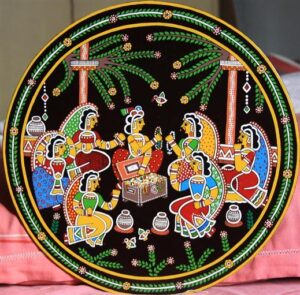
Tikuli art is mostly exported which means people outside of the culture enjoy it more than those within it. Activities and ceremonies that define Indian culture are featured in Tikuli artwork and posters.
Tikuli is still a part of tribal jewellery and is often seen in the folk songs of Nepali, Bhojpuri and Hindi. It symbolises happy wedded life with many references in Hindi literature based on the idea that being married is an identity for women.
48 - Tassar Silk Painting (Odisha)
Tussar Painting is a form of Indian folk art that date back to ancient traditions. Some places the painting is on silk and other places it’s placed on cloth or canvas. Originally, the painting came from Jagannath Temple in Puri and other locations around India.
These paintings portray a large variety of themes, from religious and mythical stories to exotic and raga (musical) narratives.
Tussar paintings are often thematic and colorful, made with natural dyes. You can often find steep borders and intricate designs in these artworks. Patta paintings are thought to have begun in 500 B.C. These were originally drawn on cloth that resembled a scroll, but over time they morphed into Tussar silk sarees.
Pata paintings were traditionally from the patta-chitra temple paintings from Odisha, Eastern India. The Tree of Life illustrates the most important aspect of human existence – life. It all starts with your culture—or in India, Kalpabrukhya. This is an adaptation of Rudraksha trees. It’s an analogy for mankind’s most vital need for life.
The whole thing is hand-painted on a natural Tussar silk background. The established colors used for paintings are brick red and black. The difficult part is to perfect every stroke with the handmade brush that the artist has been mastering for a long time.
The unique skill of this Indian folk art is in the curved stroke that starts with a dot, extends as a thin line, then grows thick, slims down again and ends in a dot – all in a single stroke. On messing up one part of the stroke the entire painting will be ruined. It takes around 2-6 months to complete one painting depending upon the size.
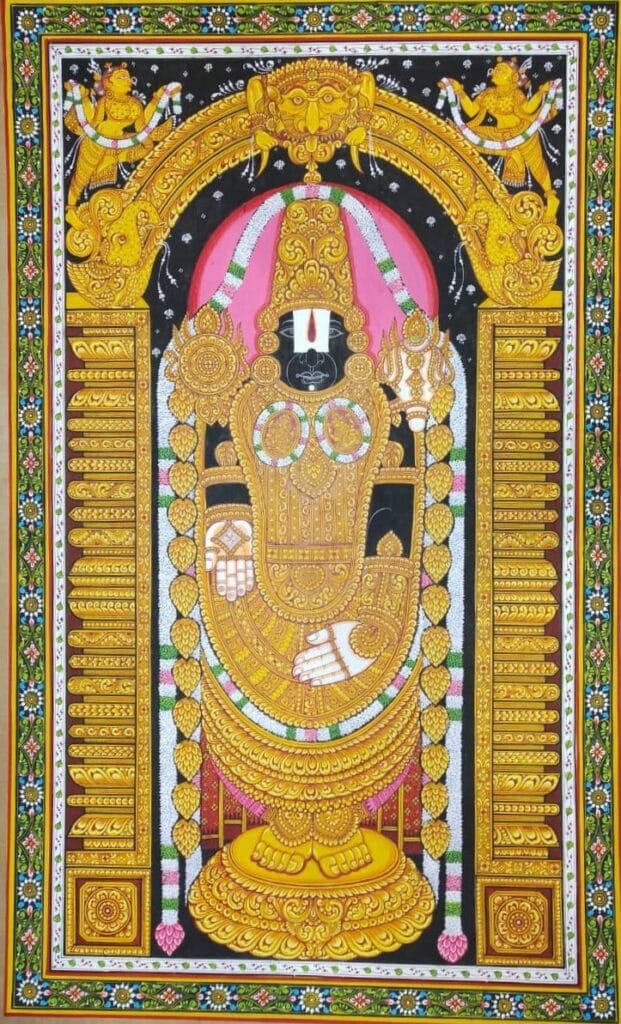
Tikuli art is mostly exported which means people outside of the culture enjoy it more than those within it. Activities and ceremonies that define Indian culture are featured in Tikuli artwork and posters.
Tikuli is still a part of tribal jewellery and is often seen in the folk songs of Nepali, Bhojpuri and Hindi. It symbolises happy wedded life with many references in Hindi literature based on the idea that being married is an identity for women.
49 - Tanjore Painting (Tamil Nadu)
Thanjavur Paintings are an ancient traditional Indian folk art form and their common theme is mythology. They demonstrate that spirituality is a necessary component of a creative work. Tanjore Painting is a classical South Indian art developed in the late 16th century in Thanjavur, also known as Tanjore in Tamil Nadu, a south Indian state.
The art of Tanjore originated in the city of Thanjavur, which was originally the capital city of the Chola Empire. It has taken on its own look, enriched with intricate architectural designs and bright colors after being influenced by the murals from imperial era. The unique style of Thanjavur or Tanjore painting as known today, is known to have flourished in the Maratha court of Thanjavur between the 17th and 19th centuries.
The Maratha people of India, who had been practicing painting for centuries, found new ways to depict the human body and naturalistic landscapes under the guidance of King Serfoji II. King played a particularly significant role in developing this artform.
These Tanjore Paintings offer a taste of the serenity and permanence associated with Puranic scenes. With their lifelike illustrations, this collection is characterised by its alluring design.
The Mughal era saw many changes in the style of artwork. The Marathas ruled over Thanjavur for nearly two centuries, and brought a distinctive style change to Thanjavur paintings. Maratha artists chose to combine the existing mural-based design with amazing details that showcased exquisite craftsmanship.
The paintings consist a well-rounded figure, a deity with almond shaped eyes. The figure would be housed in an enclosure created by means of an arch, curtains etc.
In this Indian folk art, gold leaves & sparkling stones are used as highlights for accents of the painting like ornaments, dresses etc.
It’s been said that Thanjavur paintings are brightly colored and beautiful. In a dark room, the paintings have a potent glow that’s reminiscent of a presence. Most Thanjavur paintings are made on wooden canvasses while some use glass and walls as well.
Tanjore Paintings were made by the communities of Rajus from Tanjore & Trichy, Naidus from Madurai. Eventually, with the decline of dynastic rule, the artists divided themselves into three groups. One went to Vuyaioor, another group went to Mysore and the third group stayed in Thanjavur.
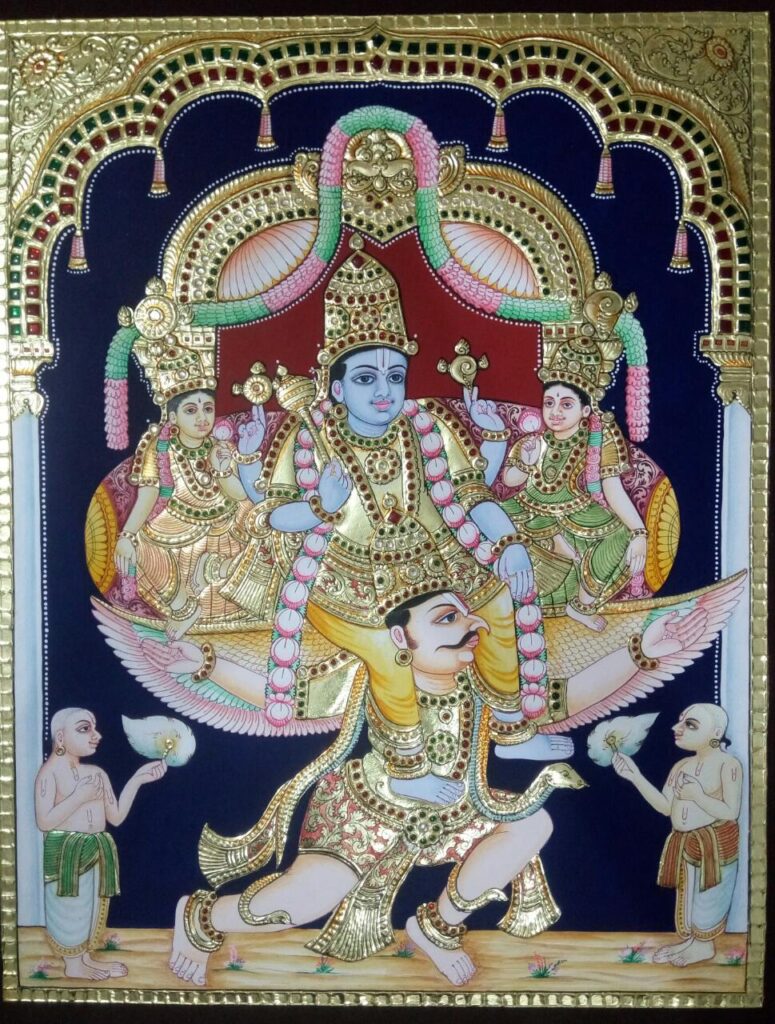
The styles developed were slight variants of each other. The emphasis at Tanjore was on studded gems and gold leaves. Vuyaioor Importance was on the decorative garland. Mysore-based paintings that have intricate work. The direct impact on Tanjore art began with the stationing of the British Garrison in Thanjavur in 1778.
Tanjore paintings are known for being made with rich, flat colors that have a glossy look. The they also use something called “gold foil” which is a layer of very small flakes of gold 22k metal leaf, bronze or brass pieces applied to the surface of a painting by hand. Stones like semi-precious stones help highlight many aspects by injecting light into the painting. The painting is made of 22-carat gold and real Tanjore stones, which produce a special glow and the shine that lasts forever.
50 - Thangka Painting (Himachal, Sikkim)
Thangka paintings are Tibetan scrolls that are hung on the wall. It is often carried in ceremonial processions by lamas. Thangka is a Tibetan art form that is unique to the culture. In Tibetan, the word “than” means “flat” and the suffix “ka” stands for “painting.”
A thangka is a kind of large painting that can be used as a scroll. When not displayed, it’s rolled up. The most common shape is an upright rectangular form. The Buddhist libraries are full of beautiful, haunting thangkas depicting scenes from the Buddha’s life. Despite their extensive history, thangkas are still very much alive due to their deep connection with Buddhism. Thangkas are paintings that Tibetan practitioners use to help them develop a close sense of connection with their respective meditational deity.
Thangka paintings are very complicated and require intense preparation. They assist mediators in concentrating on specific images, which helps them get more out of their meditations.
Early Buddhist paintings from India influenced Tibetan Buddhist painting, which evolved from those painting traditions found in places like the Ajanta Caves and Dunhuang on the Silk Road. Early examples of these paintings were elaborate on a wall, but later became simpler.
Tibetan Thangka paintings developed alongside traditional Tibetan Buddhist wall paintings. Many of the earliest examples of these paintings on silk/cloth date back to around 1,000 AD and were found in various caves at Dunhuang (an ancient city in northwestern China). Translating the earliest known fragments of Theravada canonical scriptures from Pallava script into Old Mon can be dated to. Earlier Thangka forms of paintings were made in ancient scriptures and manuscripts and textiles.
Thangka painting is practiced in Ladakh, Sikkim, Arunachal Pradesh, and Lahaul and Spiti, and Kangra districts of Himachal Pradesh in India. In Dharamshala, Thangka painting is practiced by Tibetans in exile.
The art of thangka painting can take years to perfect, but anyone willing to put the time into learning it can do so. Unlike most other forms of art, there are no specific gender rules. Early thangkas were seen as a form of meditation, where the artist communicates with the deity.
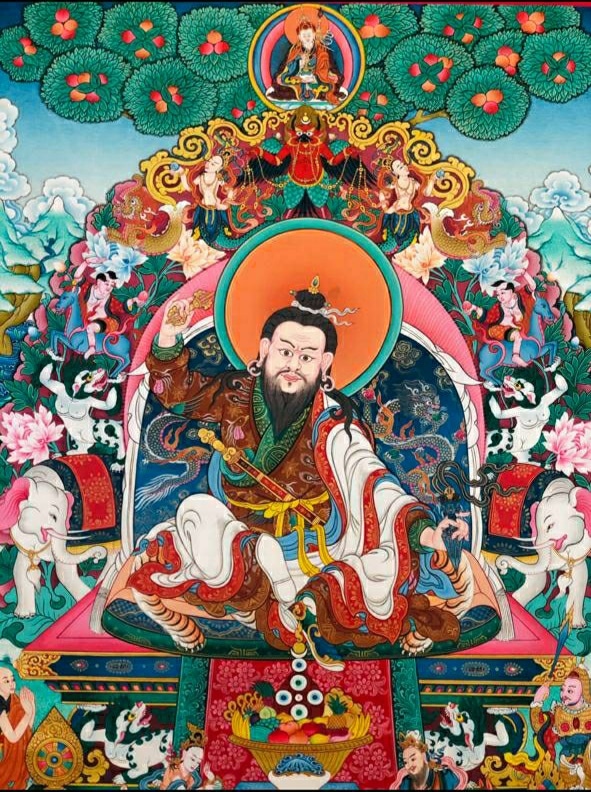
This person would first need to go through a special initiation by the lama that would bestow him with the skills of painting thangka paintings. Next under the guidance of an experienced thangka artist he paints for many years, learning his trade.
Dengki artists need to have a thorough knowledge of the Buddhist scriptures in order to create paintings. Knowledge of their strict rules is essential in order to make accurate depictions of them. Buddhist scriptures give instructions for this.
A Thangka artist learns to sketch Buddhist symbols and figures of deities for the first few years. The Thangka art is a ritual in Himalayan Buddhism and is known to be a time consuming process. It can take up to twelve years of practice before the artist becomes an expert.
51 - Santhal Painting (West Bengal)
The Santhal people are an indigenous tribal community in India who live in the states of Jharkhand, Bihar, West Bengal and Odisha. The paintings are made with locally sourced materials such as rice paste, tree bark, cow dung and natural pigments.
Like any other tribe the Santals have an exclusive artistic perception rooted in their cultural traditions and physical environs.
Santiniketan is a central center for Indian art and is renowned for being the home of Rabindranath Tagore. Tagore was interested in the Santhals when he visited Santiniketan’s “Hamlet” close to the school and convinced Nandalal Basu to teach art in his own personal school.
The Santhals are known for painting the walls of their huts during their village festival. This ceremony, they believe, is for ceremonial performances as well as an outlet to express themselves. They worship a stone as a formless representation of the divine. They sing about the burden of their life and provide an interesting portrait of their everyday experiences.
The figures are mostly static, often multicolor, and artistic rather than realistic projections. Figures can consist of humans, animals, and creatures joining together to form one head. Mother & Child as well as human & animal couples are brought together by love and unity.
A panoramic view of the village forms the background, with women carrying firewood and water on their heads, Men driving the bullock cart to the market, dancing and singing under a tree, a couple under flowering creepers; a family going for cultivation; men and women cutting wood, gathering fire wood, carrying water on the head; hunters returning with their catch ; fishing; taking mud pots in a cart to the village market for sale, flying kites and swinging, brothers of the bridegroom carrying the bride in a basket. These tell of the strong family bond and brimming with life diffusing a rare energy that animates Santhal art.
Santhal paintings, a very unique Indian folk art are done in primary colors, with leafy patterns in the foreground, background and borders. The animals, birds and insects are depicted directly and with child-like simplicity.
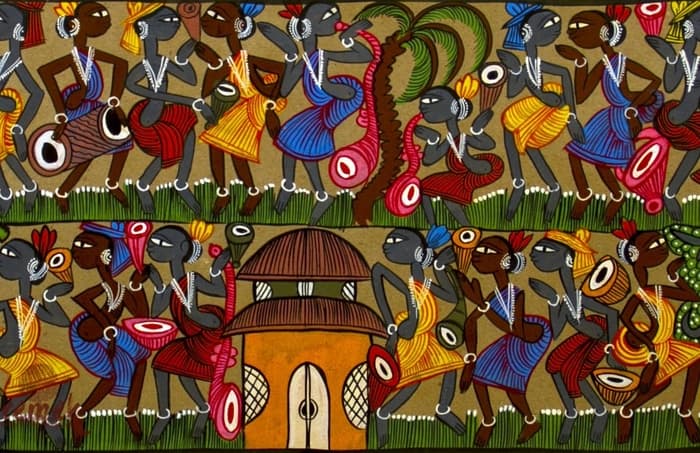
The color scheme holds no logic. A bird or a fish appears in many colors. The drawings originate from the tribal groups Santhals, for which there are certain colors used. The older generation still sticks to natural colors, whereas the younger ones prefer artificial because they allow a greater variety.
52 - Warli Folk Painting (Maharashtra)
Warli painting from Maharashtra is one of the oldest styles of Indian folk art that’s managed to persist for thousands of years. Warli paintings are mainly created by Tribal people from North Sahyabadri Range in India.
The Warli tribe is one of the largest in India, located outside of Mumbai. Despite being close to one of the largest cities in India, The Warli culture is centered on the concept of Mother Nature and elements of nature are often focal points depicted in Warli painting.
Many Warli paintings depict the Tarpa dance as a central component. The Tarpa is a kind of trumpet-like instrument that different men take turns playing. The dancers pair up, intertwining their hands and circling the tarpa player. They then follow him in a turning and pressing manner; he can’t turn his back to them because they will always be around him.
Farmers make up a large proportion of the tribe and provide food for many people. They respect wildlife and nature because it’s important to their way of life as well as providing them with food.
Warli artists often use their clay huts as a backdrop for their paintings, as people did with the cave paintings before them. These basic wall paintings use simple geometric shapes: a circle, triangle and square.
These shapes represent different aspects of nature. The circle and the triangle come from their observation of nature. The circle represents the sun and the moon, while the triangle is derived from mountains and pointed trees.
The human body is represented by two intersecting triangles: the top triangle represents the torso, the bottom one the pelvis. Their precarious equilibrium symbolizes the balance of the universe. The representation also has the practical and amusing advantage of animating the bodies.
Warli art often depicts triangles which are different sizes depending on their gender. A triangle is usually larger or wider at the top if it represents a man, and wider towards the bottom if it represents a woman.
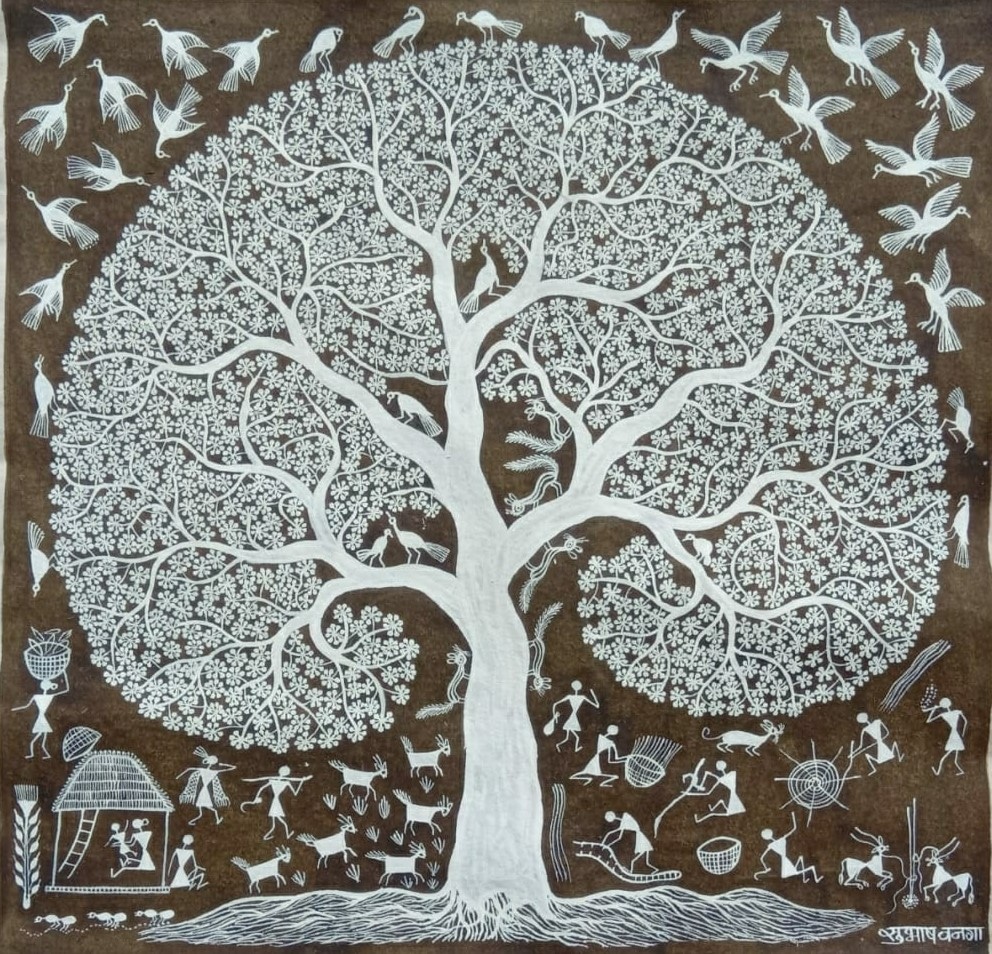
Why Should You Share & Promote These Exotic Forms of Indigenous Indian Folk Art?
The Indian culture is one that has been passed on from generation to generation through traditions and oral folklore. These Indian folk arts are a representation of the Indian culture. It is a form of art that has been created in by the people in India, for the people in India.
The problem is that these Indian folk arts are dying out as people take them less seriously and do not pass them on to the next generation. The reason for this is that there are few incentives to keep these Indian folk arts alive. There are also few opportunities for these artists to create their works without competition from dealers and showrooms who selling ready-made products at cheaper prices.
Traditional Indian folk art is losing out to western artforms. One of the main reasons for the decline in traditional Indian folk art is a dramatic economic growth. As India has developed, there has been less emphasis on local traditions and more preference for what is imported from abroad.
Indian folk art forms that are considered exotic and indigenous usually not shared or promoted on a global scale. With the advancements in technology and media, more and more people will hopefully and get interested in these Indian folk art forms.
Therefore, we should share and promote these Indian folk art forms to raise awareness among the masses about their existence. Sharing them on social media platforms, traditional media platforms such as TV channels, newspapers etc. is a great way to generate interest for these artforms.
As we all know, art is one of our most powerful tool to communicate with others especially when it comes to culture and heritage of a region or nation. Lets celebrate the rich culture of Indian folk art and do our bit to pass it on to the next generation.
Conclusion: The Future of Indian Folk Arts Depends on Our Support
In conclusion, when understanding the challenges faced by traditional Indian folk arts and crafts, it’s important to remember that these traditions are not just a simple collection of items. They are reflections of our history, culture, and identity.
So why should we care? It is clear that Indian folk art form is dying out with each generation, but there are ways that we can help to save it.
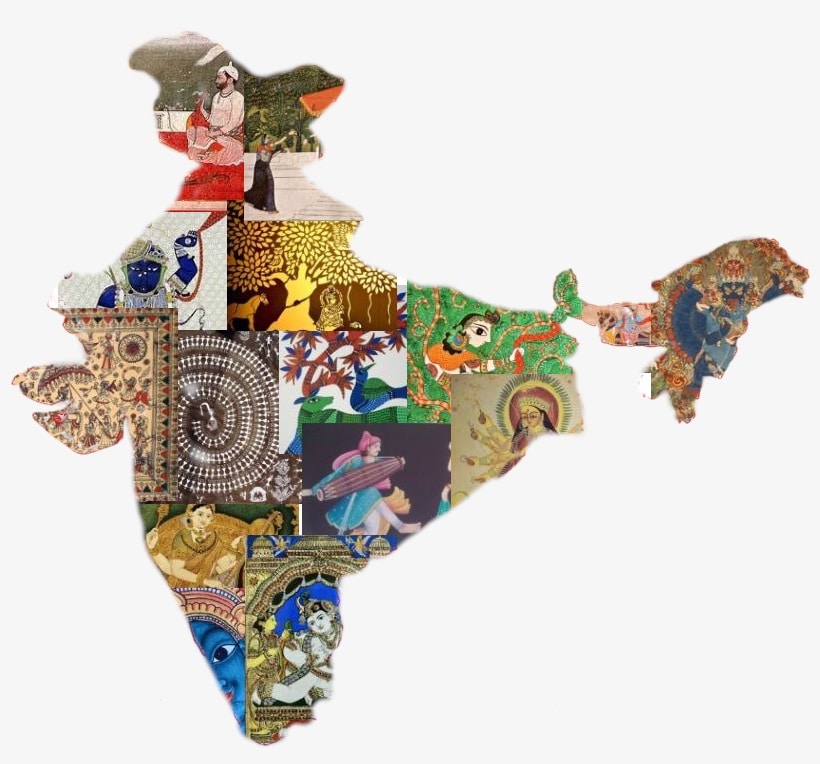
The sense of identity one gets by working with their hands is what makes Indian folk art so special. Indian folk art is a way of life, every artisan’s work speaks to them about their culture which reflects in their craftsmanship. The traditional Indian folk art of folklore and tribal art are a great way to explore the culture of a people.
The future of Indian Folk Arts depends on the support it gets from the government and the public. The more these Indian folk arts are appreciated by people, the more artists will strive to create pieces that will be remembered for many generations to come.
Credit and References
How many new Indian Folk Art did you discover today?
Thank you for investing your valuable time to go through the article on the “52 Indian Folk Art forms that we must protect and pass it on to the next generation”. Please feel free to leave your comments below or share your own journey and experiences in preserving Indian folk art.


67 comments on “52 Incredible Indian Folk Art Forms That We Must Protect in Indian Art and Culture”
Chandra Bhushan Kumar
Very Nice
admin
Thank you Chandra Bhushan Ji,
Appreciated,
Senthil
Kiran
Very interesting read!
admin
Thanks Kiran
Mandakini Mathur
Very inspiring initiative to give an overview of the prominent folk arts ! This is indeed like a peephole into the very soul of India!
Khatri ibrahim
Ajrakhprint ki kruti bhej sakta hu me?pls help
Senthil Vel
Whatsapp: +61414297179
Soni Singh
Very interesting & informative.
admin
Thank you Soni Ji
Avtar Singh
you did marvellous job to revive these folk art. God bless you.
admin
Thank you Avatar Ji.
Avtar Singh
I am feeling proud that you add my painting in your article
admin
Dear Avatar Ji,
Your work needs recognition and happy had the opportunity to share your work. Keep up the good work.
All the very best
Senthil
Asmita
Wow… Its nice to know about Indian Folk Art in detail… Very good information which is really helpful to Artist and students… Thanks for sharing.. Good Work Senthil Ji…
admin
Thank you Asmita Ji,
Appreciated, Senthil Vel
Priya
Wonderful initiative by iifa. Great efforts for providing such discriptive information about our native arts. This is an amazing platform for the growth of Indian art forms.
Senthil Vel
Thanks Priya, thanks for your support
Aparna
Very informative . Watching creation videos was very interesting . Thank you for such a thorough informative read .
Senthil Vel
Thank you Aparna for your support
VB
I want to thank you for bringing up this topic and provide ample information in a very structured way. Can’t stress enough to all who are reading this article that how important it is to talk about our diminishing art and find ways to support local artists.
Senthil Vel
True, the first step is to start the conversation. Thank you so much for your feedback. Gives the energy to do more 🙂
Indrani Chandra
This in itself is a treasure trove of information. Great job done….
Senthil Vel
Thank you so much
Kavita Harkut
Hello all team members . The article written by senthilji is very much inspiring & deep information is given in short for all enthusiastic art lovers. Very great job by him to gatther all arts in one place….
Also very thankful to him as he included my Artwork Masan painting in his gallery. ☺🙏
Deepali gupta
Incredibal work .good information on Indian art forms .we should support these arts and artists .
But I think there is one more artform the MANJUSHA PAINTINGS ,which is not too much popular .
Senthil Vel
Hi Deepali,
Thanks for your feedback and adding one more folk art to the list. We will do some more research and also add it in our next publication. If would like to share some more information on the Manjusha Paintings, please send it to iifagorg@gmail.com, Thank you, Senthil
Rajesh vangad
Hii from Rajesh vangad
Nice information about warli paintings and also other paintings. Thank you.
Senthil Vel
Hi Deepali,
thanks for your kind feedback, appreciated.
Sanjay Kumar Baral
Really,our culture is our identity.
If we don’t protect or conserve our culture ,we will ultimately lose our identity.
In Odisha, there is a very popular verse :
पुण्य जन्म भूमि पुण्य देवालय
उद्धरने के लिए करने से तन क्षय
मानव जीवन होता है सफल
ये महादीक्षा क्या समझेगा उत्कल ।
( Utkal is the old name of Odisha)
So many many thanks for the wonderful documentation and research.
Whether any printed copy of the matter ( such as a brochure or booklet or coffee table book ) is available ? I think that will be a proud possession for all Indians.
🙏🏻 🙏🏻 🙏🏻
Senthil Vel
Namaste Sanjay Ji,
Thanks for your support and kind feedback. Special thanks for sharing a very inspiring verse from Utkal. Very much appreciated.
Yes, we are working on the publication, we hope to release it early next year. Will certainly organise a free copy for you 🙂
Best wishes,
Senthil Vel
shobha rani .J
Very informative and interesting.
Indira S
WOW! This is a fantastic post. I hadn’t known/heard of all of them. Thank you for a very educational and informative presentation, Senthil. Is there a printed booklet of the same available?
Senthil Vel
Thank you so much for your feedback. Yes, we are working on the hard copy book, planning to release next year. Will notify you once its available.
The Complete Guide to Buy Tanjore Painting Online – Senthil Vel
[…] paintings are a part of the traditional South Indian folk arts. They are in the style of temple paintings, depicting scenes largely from Hindu […]
Sk Aktar Hosen
This article is very helpful
Srinivasan. V
Good
Tanjore painting Online USA |Genuine| International Indian Folk Art Gallery
[…] especially Tanjore painting or also called as Thanjavur painting has been an important aspect of Indian culture for centuries. It wasn’t until 2000 that the Tanjore painting in USA became popular, especially with so […]
Buy Indian Folk Art With Bitcoin And Other Major Cryptocurrencies
[…] are open to blockchain technology. Investors and art collectors who wants to acquire traditional Indian Folk Art can now also use using their cryptocurrency for […]
Anjali Rajput
Finally!! A detailed article on Indian folk Art Culture. This article is very very helpful for the people like me who is not aware about the type of indian folk art.
I have bookmarked the article link for my future references.
Keep writing.
Senthil Vel
Thank you so much, greatly appreciated.
Team IIFAG.
My Guru, Shilp Guru Sri Venkatesa Raja. Traditional Tanjore Painting Artist
[…] paintings are a part of the traditional South Indian folk arts. They are in the style of temple paintings, depicting scenes largely from Hindu […]
Learn Traditional Tanjore Painting Online – International Indian Folk Art Gallery
[…] Painting is one of the most beautiful Indian Folk Arts that takes its origin from the murals of the Vijayanagara Period (1500-1600 AD), acquired its rich […]
Sonal vidhani
Nice information on 52 Indian art forms, many of them, we are unknown, very thankful to you sir,creation videos were very interesting, learn making process of many arts which are very informative for me, u r doing great job for promoting indian folk art, best for future.
Senthil Vel
Thank you so much for your kind words. It means a lot of us.
Team IIFAG.
Endangered Folk Arts of India Exhibition & Sale – International Indian Folk Art Gallery
[…] will be curating a unique collection of around 80 artifacts. 40 handpicked artworks from all part of the country and another 40 winning artwork from Lok Kala Ratna Award 2021 (see below for […]
Vishal Jalindar Lohar
I’m Vishal Lohar Artist. I want to sell my canvas paintings
Senthil Vel
Hi Vishal,
Many thanks for reaching out. Please contact us on WhatsApp +61414297179
Best wishes
IIFAG Team
Umarani
very nice and informative article for people like us I know very little about art but very interested to know more about folk art . I have saved this article for future reference thank you very much for such a great job
Dushyant Dangi
I know only very few art forms from the list. Highly informative.
10 Indian Handicrafts that You Probably Didn't Know Existed
[…] Indian Handicrafts […]
World Art Day II: Art Forms throughout India – Variations and Similarities Across Cultures – Musepad
[…] Picture credits:https://indianfolkart.org/52-ifa/ […]
Far from the protection of art and artists, we find the Indian Government killing artists and their innovation and creation – Albert Ashok's Diary
[…] Artists, who draw and paint in India might be millions of millions in number. They are a kind of most vulnerable and gullible poor people. Most live under poverty lines. There are more than 50 different practised arts including folk arts. […]
Archana Ranjan
very nice information but why not crafts name? only Pipli from Odisha you have mentioned.
There are a lot of crafts which are disappeared. I am craft based skilled person.
Senthil Vel
Hi Archana,
Could you please share information and we’ll include in the next publication. email to iifagorg@gmail.com
Thank you so much,
Senthil
THE DISAPPEARING TRADITIONAL FOLK ARTS OF INDIA | Endangered Strokes
[…] roots, yet these art forms have suffered from a decline, pushing them on the verge of extinction. A threat is looming for the folk arts. Throughout history, folk art has slowly disappeared as the wo… Art and culture were once the basis of India’s prosperity, but are now being challenged with […]
विश्व की सबसे लम्बी पट्टचित्र पेंटिंग
[…] पर समय-समय पर कुछ न कुछ रोमांचित और हैरान कर देने वाला घटित होता ही रहता […]
Not So Complex Indian Art Forms But Seem To Be! – Rooftop
[…] of the Mughal Empire to the Indus Valley cave drawings, people have been creating art on the Indian subcontinent for 12,000 years. The recurring complex Indian artform motifs influenced Indian […]
Tanjore Painting in Melbourne Australia
[…] The Tanjore Painting Melbourne exhibition was held from Friday 26th to Sunday 28th of August 2022 at Shri Siva Vishnu Temple, Carrum Downs and, featured around 90 endangered folk arts of India. […]
Srinivasan. V
Good
Ancient Indian Art Exhibition: DakshinaChitra Heritage Museum, Chennai – International Indian Folk Art Gallery
[…] are more than fifty traditional folk arts indigenous and unique to India, each style distinct and originating from various states and […]
V. Sravana Preethi
Very interesting. Really its an amazing work, in bringing out the different art forms of various states of India which are unique. Creation of videos were quite interesting, and it shows your dedication in bringing out the artists behind every folk art of India. I really appreciate the team work behind.
Senthil Vel
Thank you so much for your kind feedback
Senthil Vel
Neelam
Include the mud art of Bastsr chattishgadh . They create breathtakingly beautiful mud articles
2024 International Children’s Art Competition – International Indian Folk Art Gallery
[…] believe that children hold the key to reviving Indian Folk Art for future generations. This is an incredible opportunity for teachers and students to embark on this beautiful journey […]
Amit bhatt
Please add garhwali paintings of Uttarakhand
Senthil Vel
Thank you for your feedback. Are you able to share more information about this artform? Could you please share details to our email iifagorg@gmail.com
2025 Indian Art Exhibition At Parliament Of Victoria, Australia – International Indian Folk Art Gallery
[…] Indian Art Exhibition – Endangered Folk Arts Of India […]